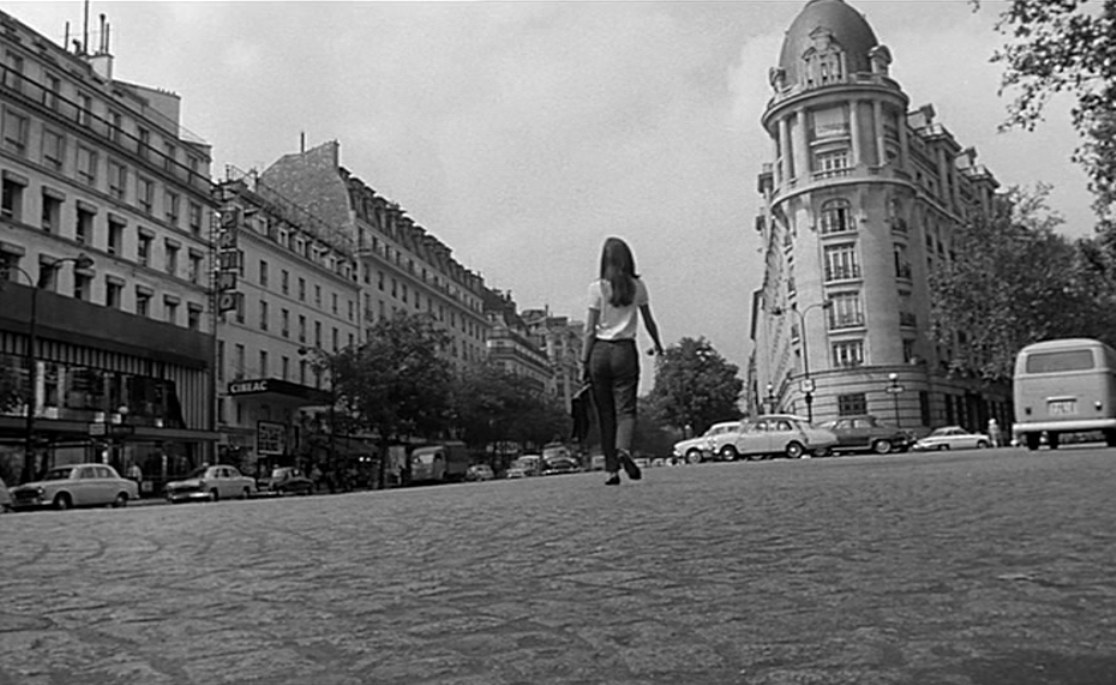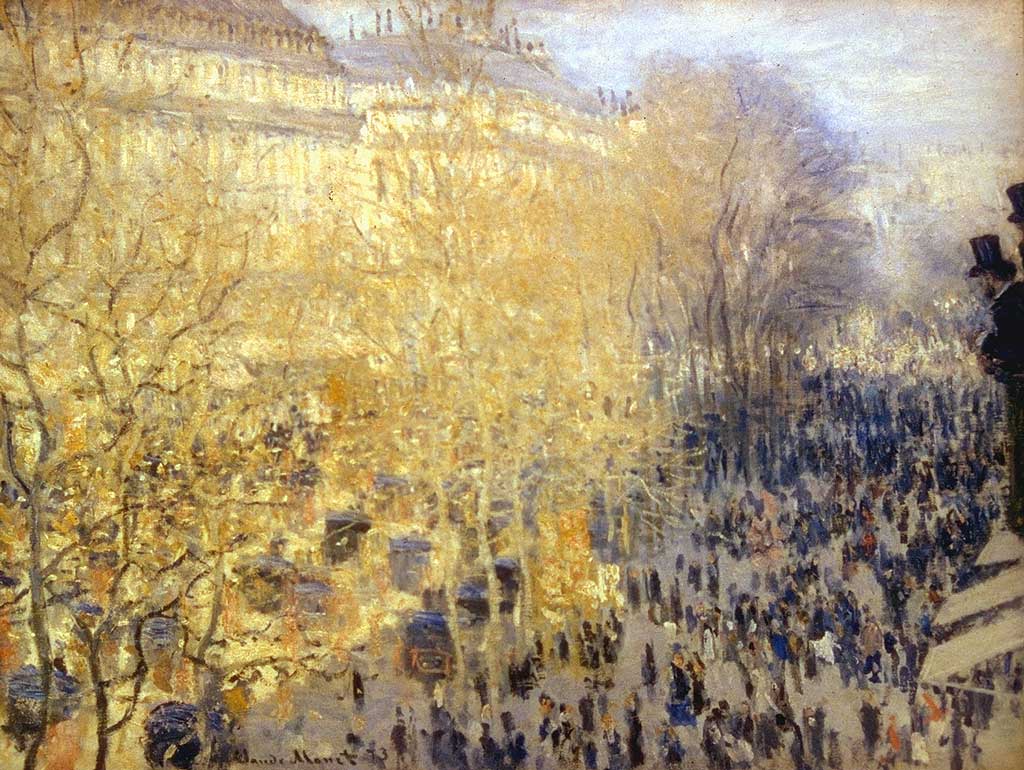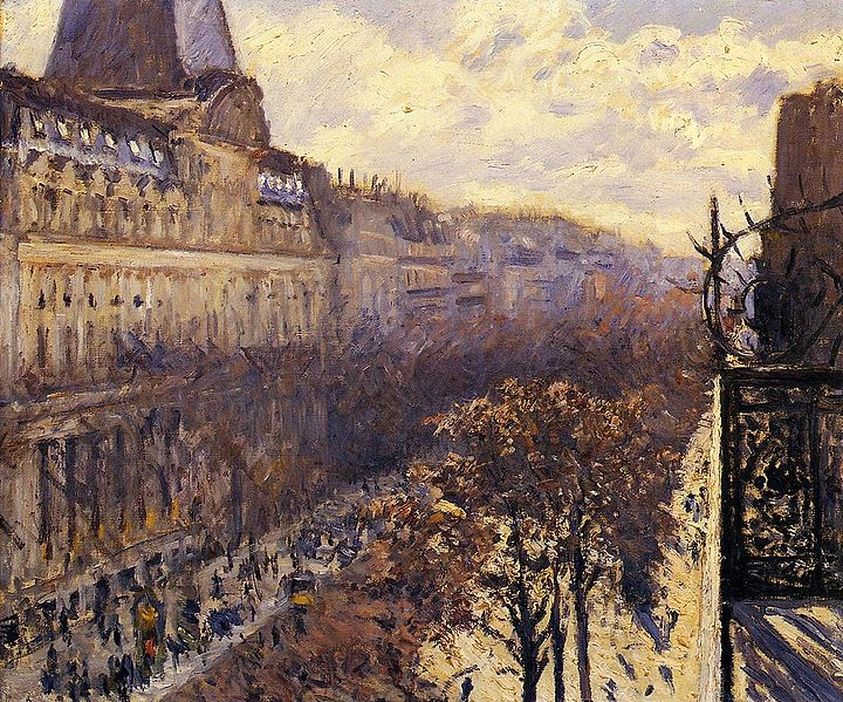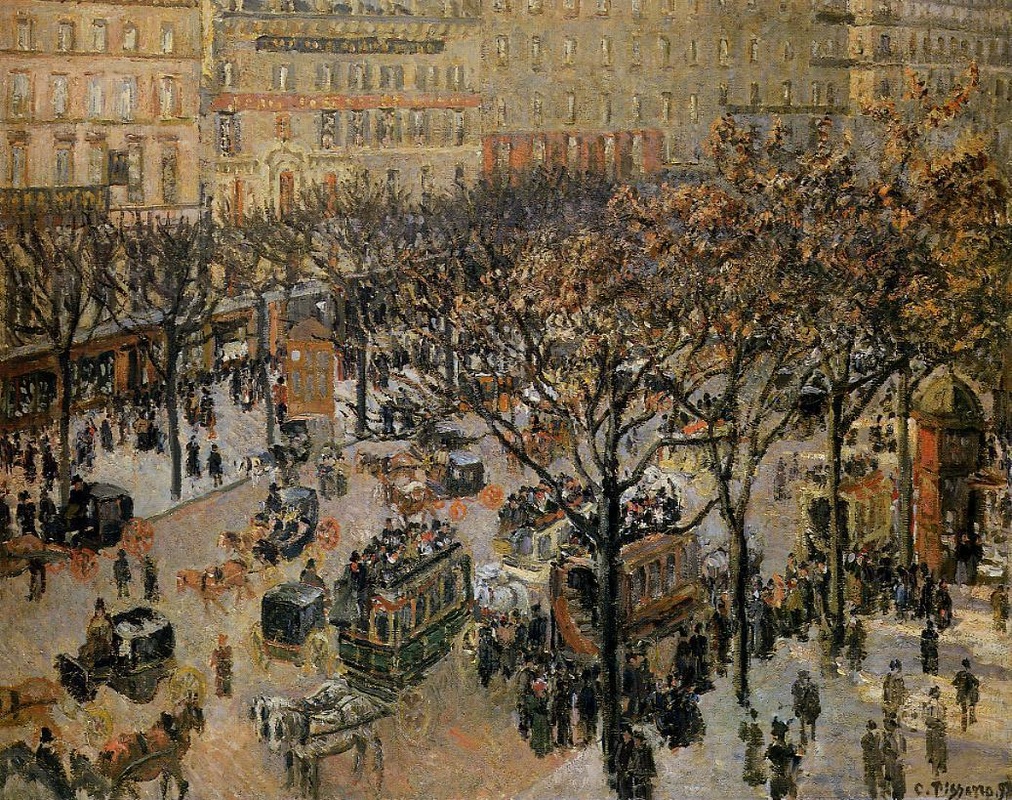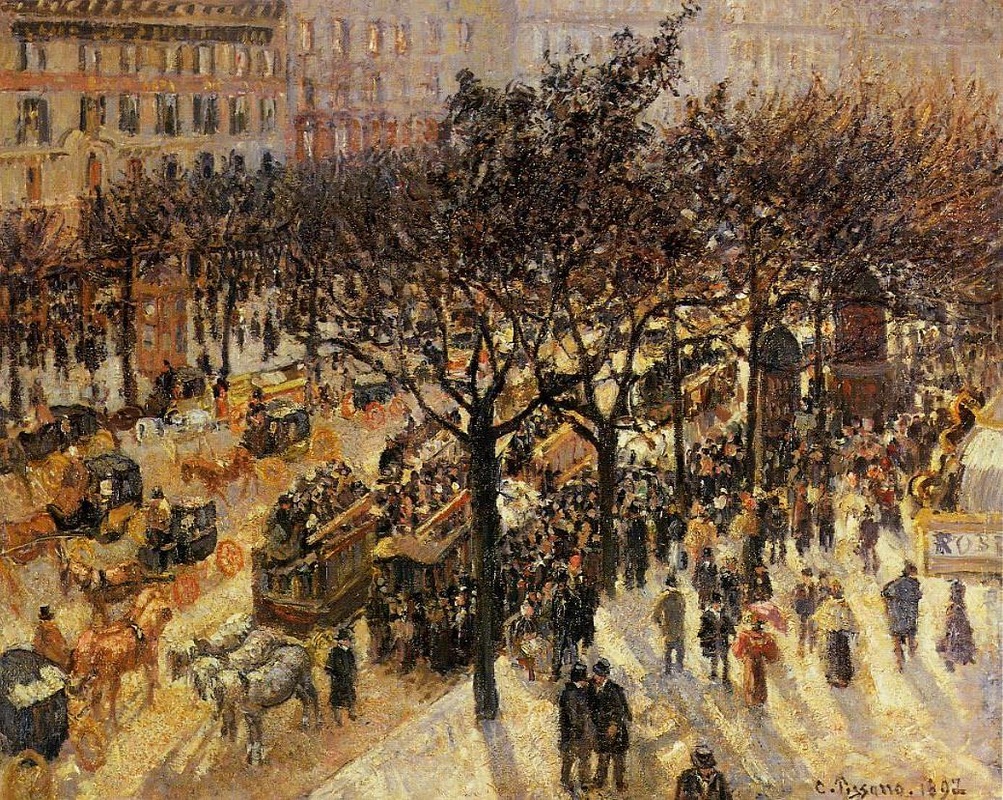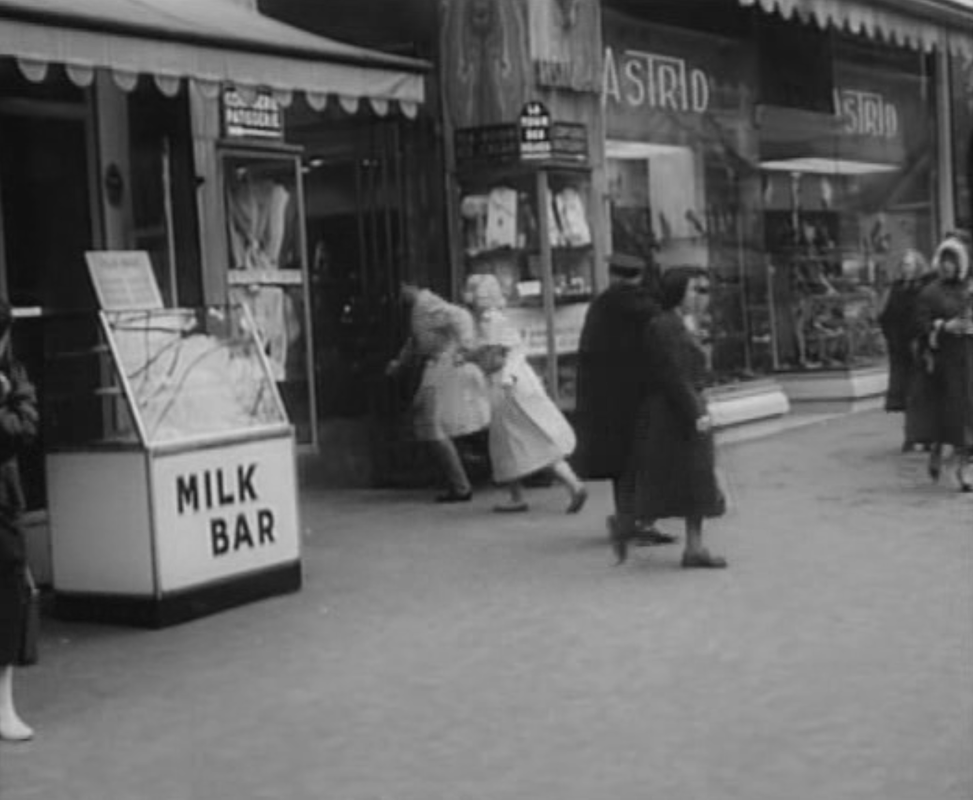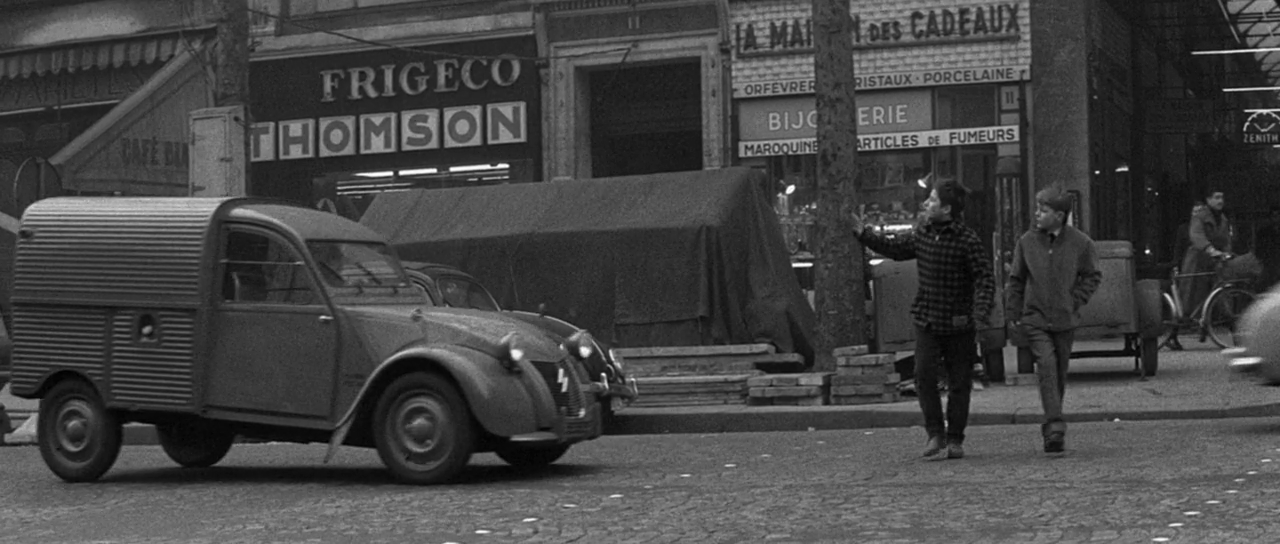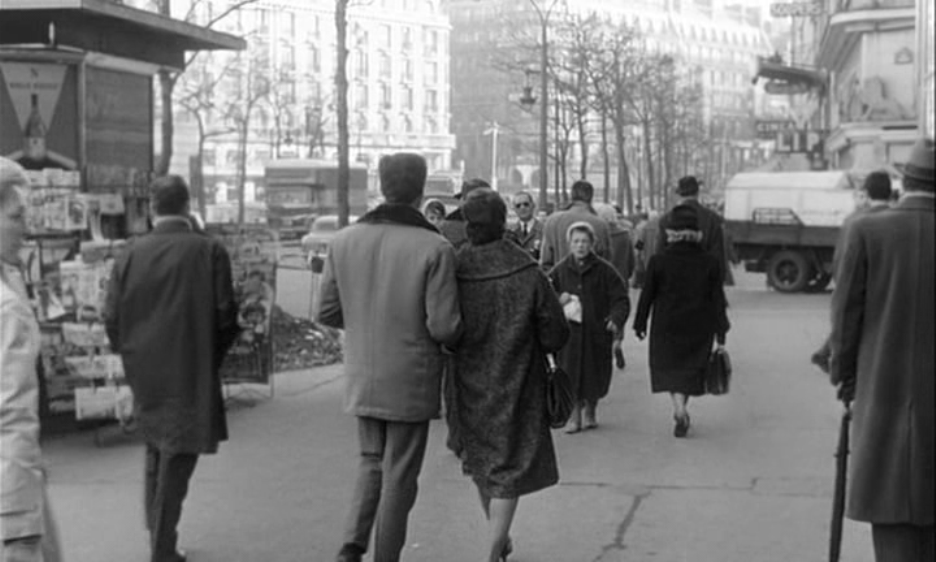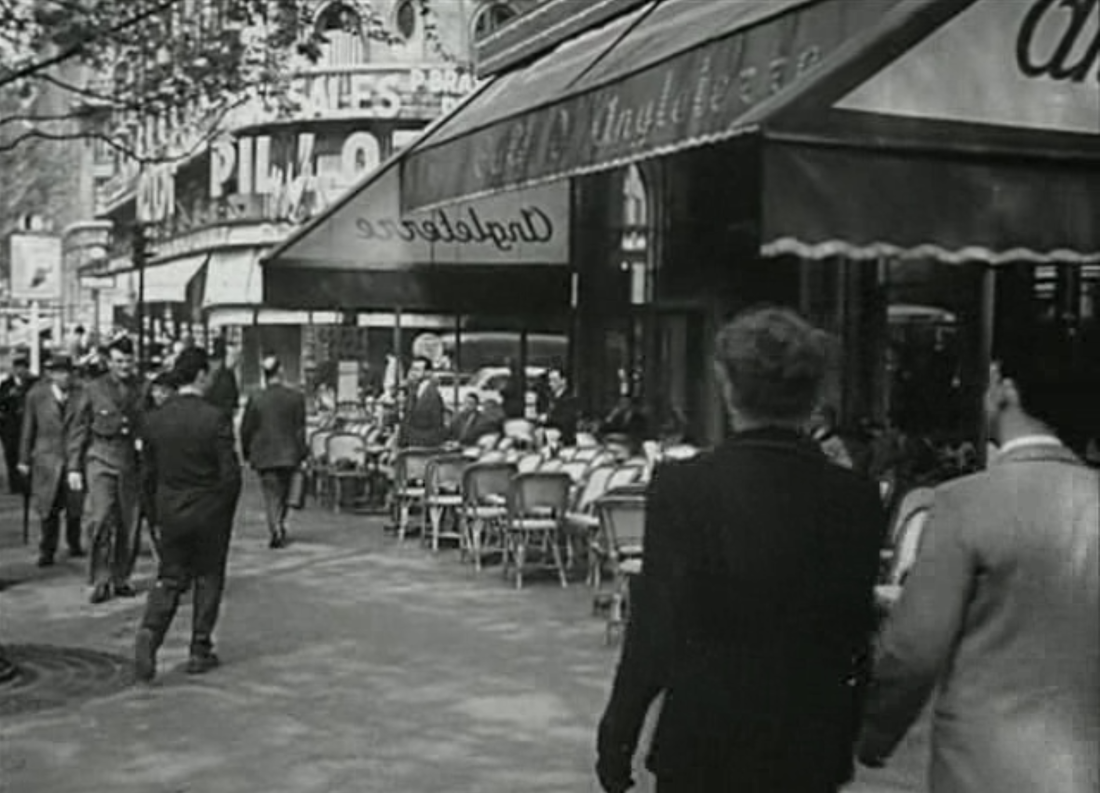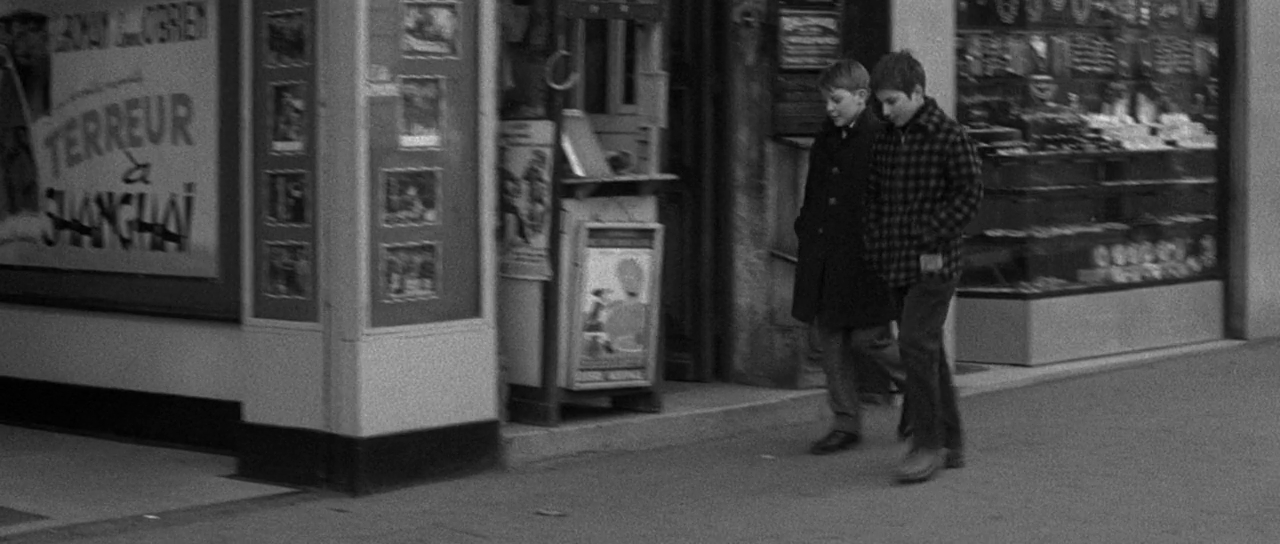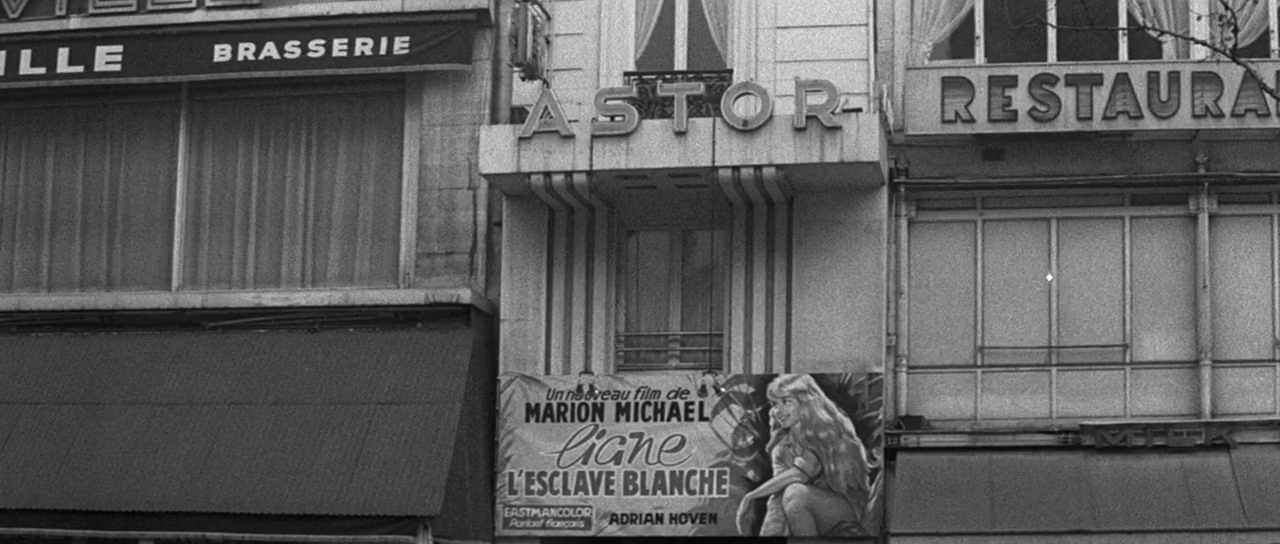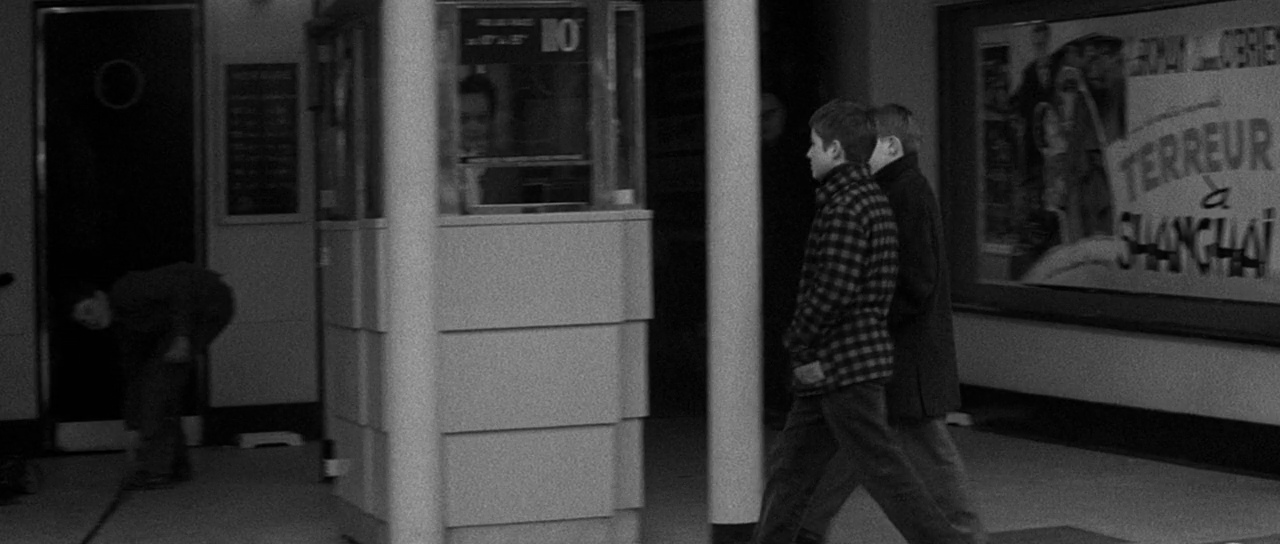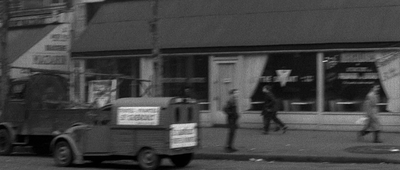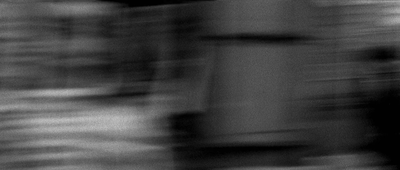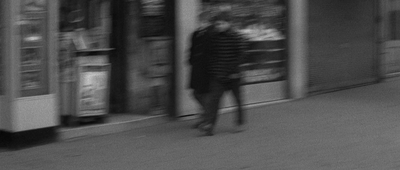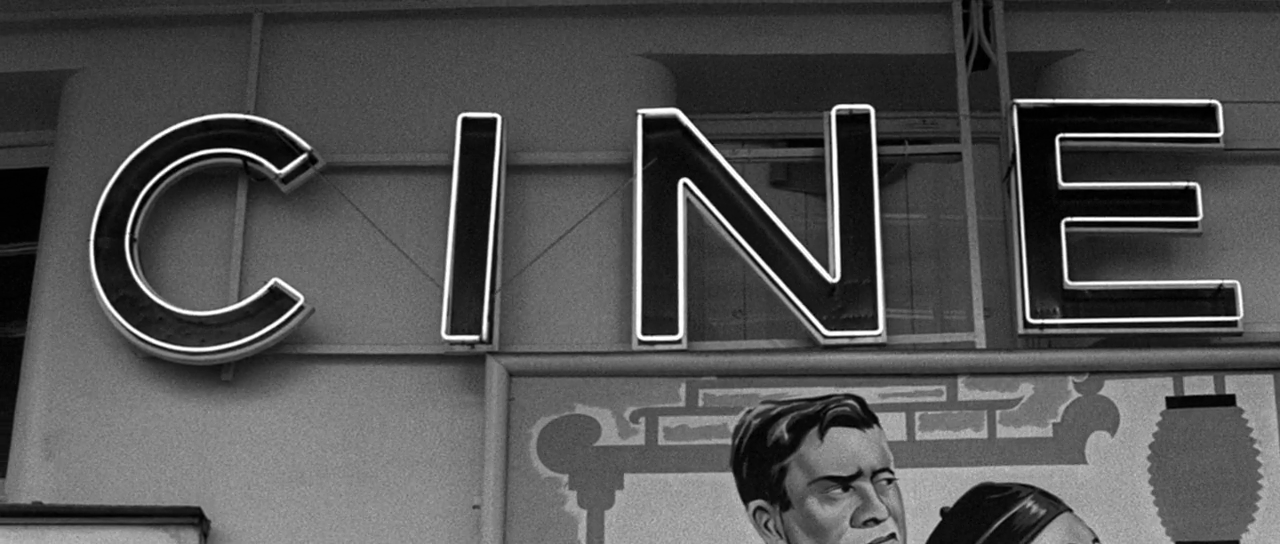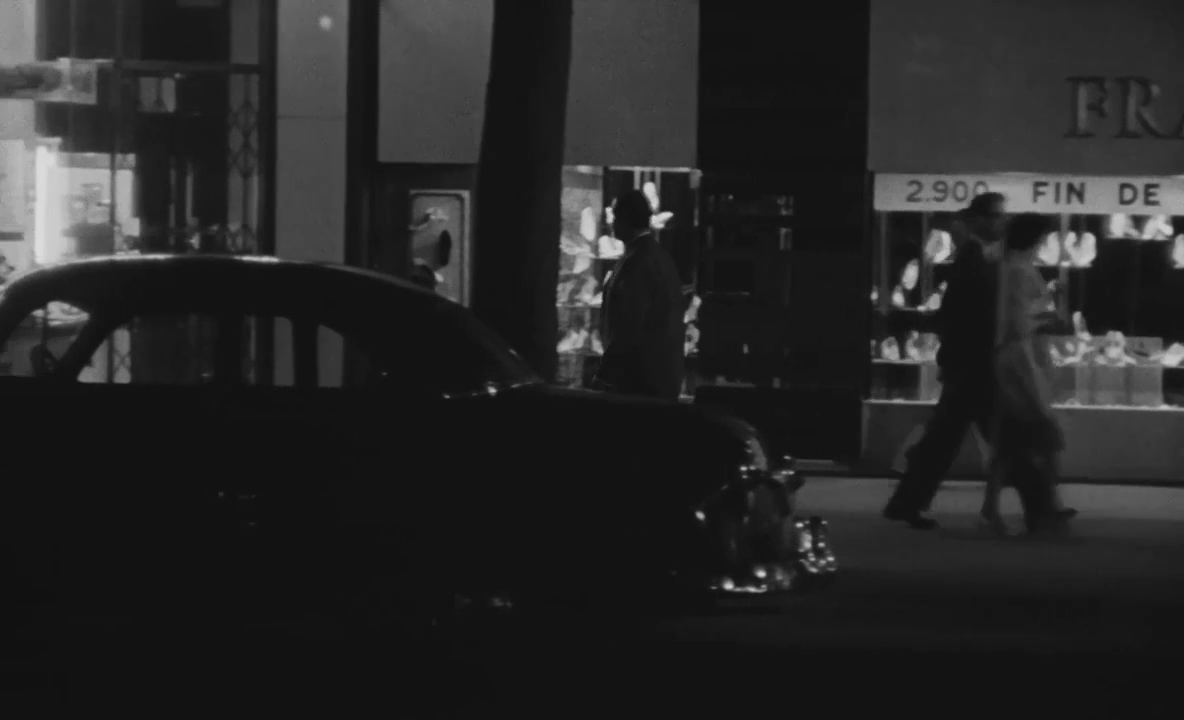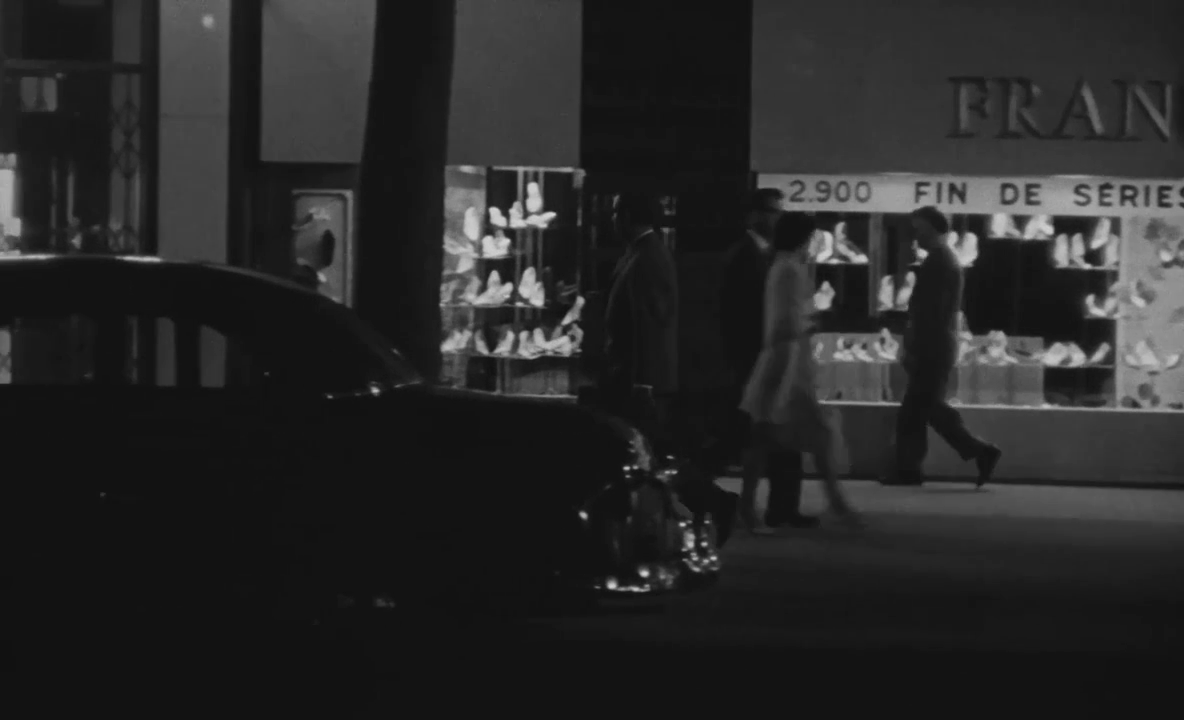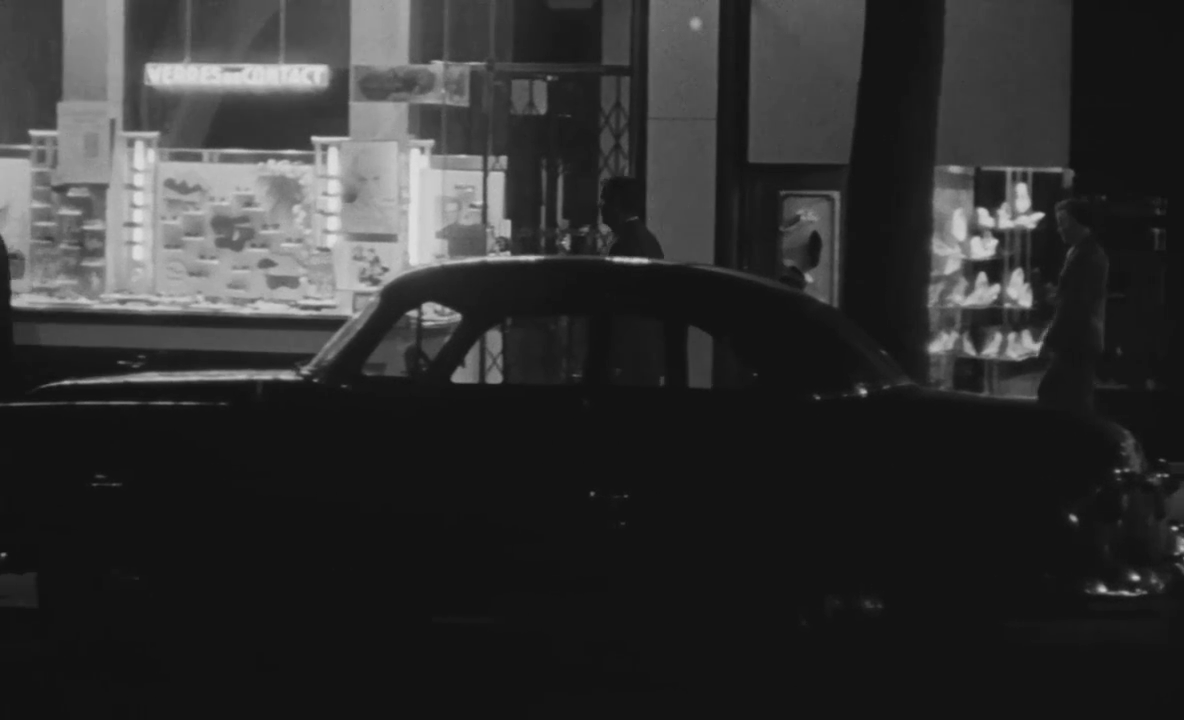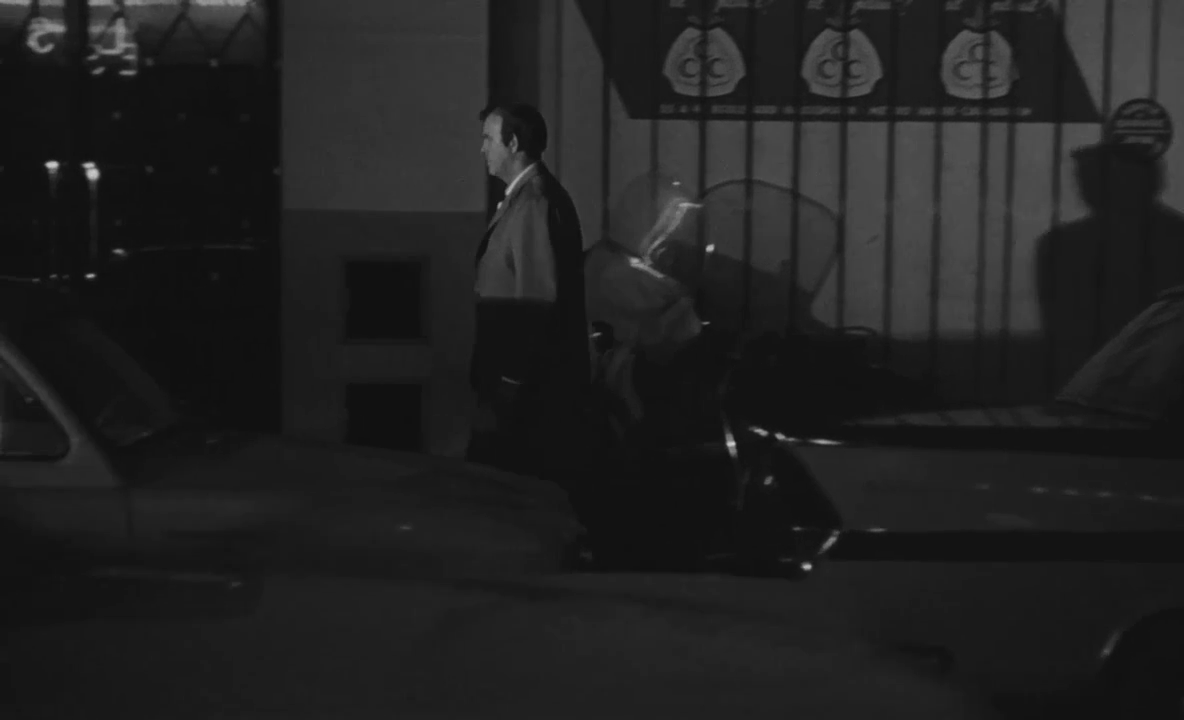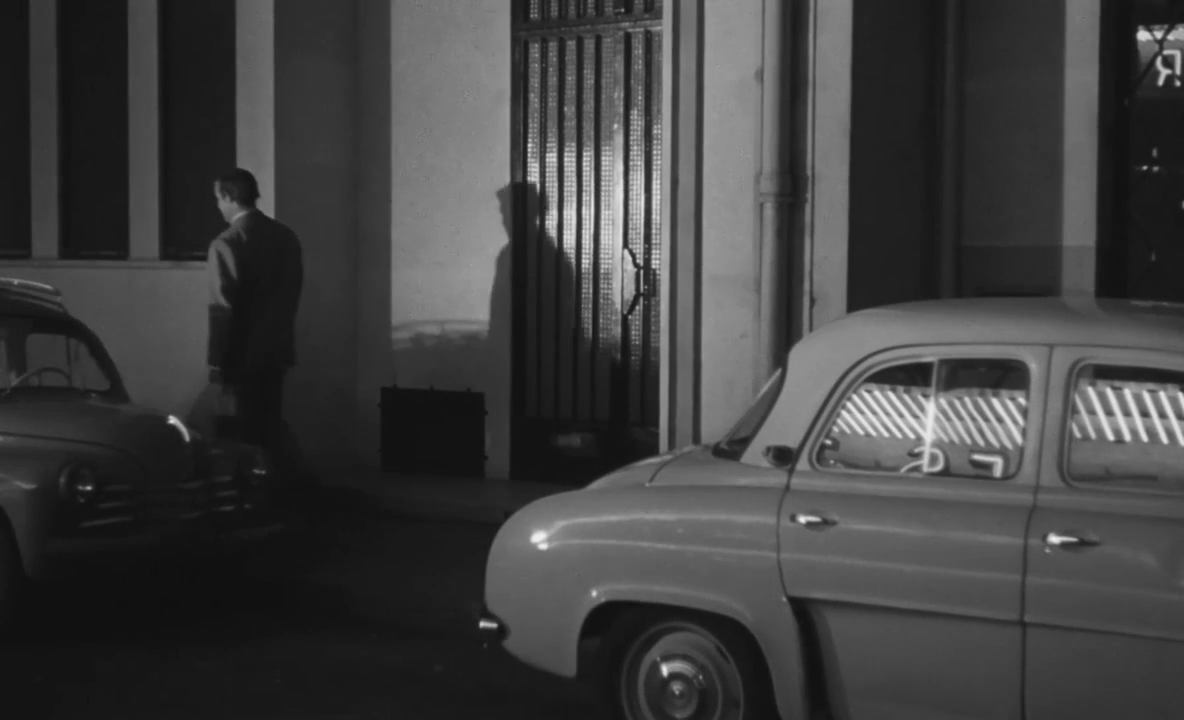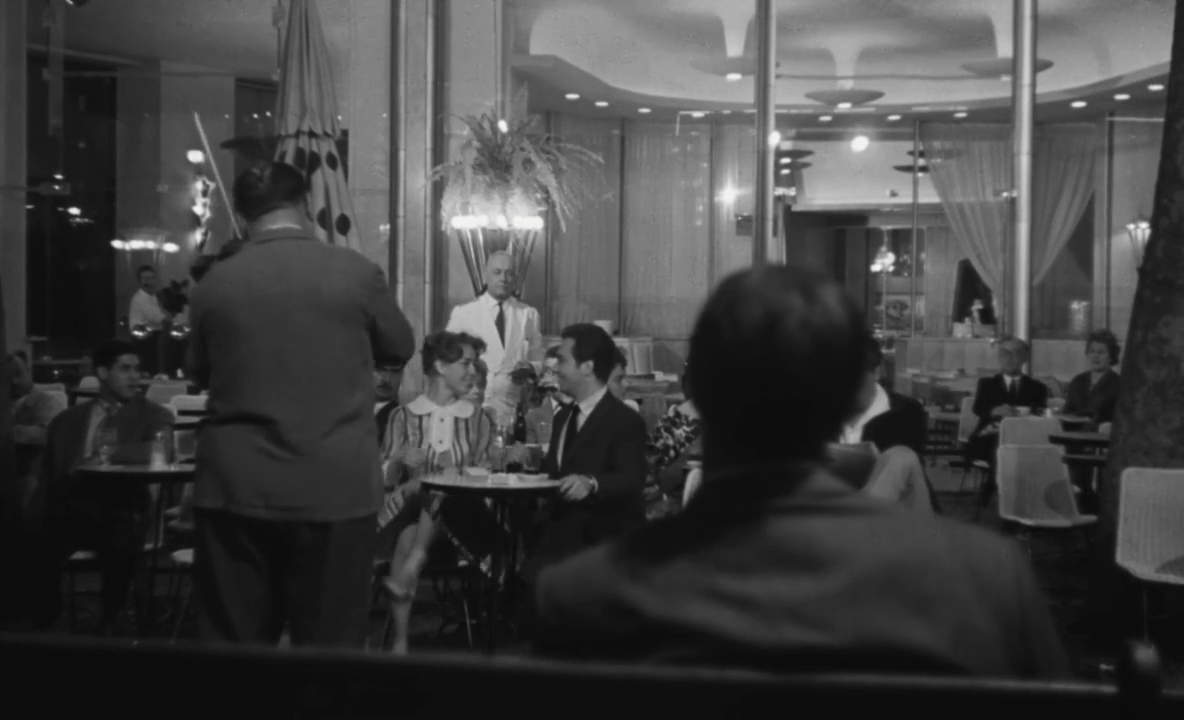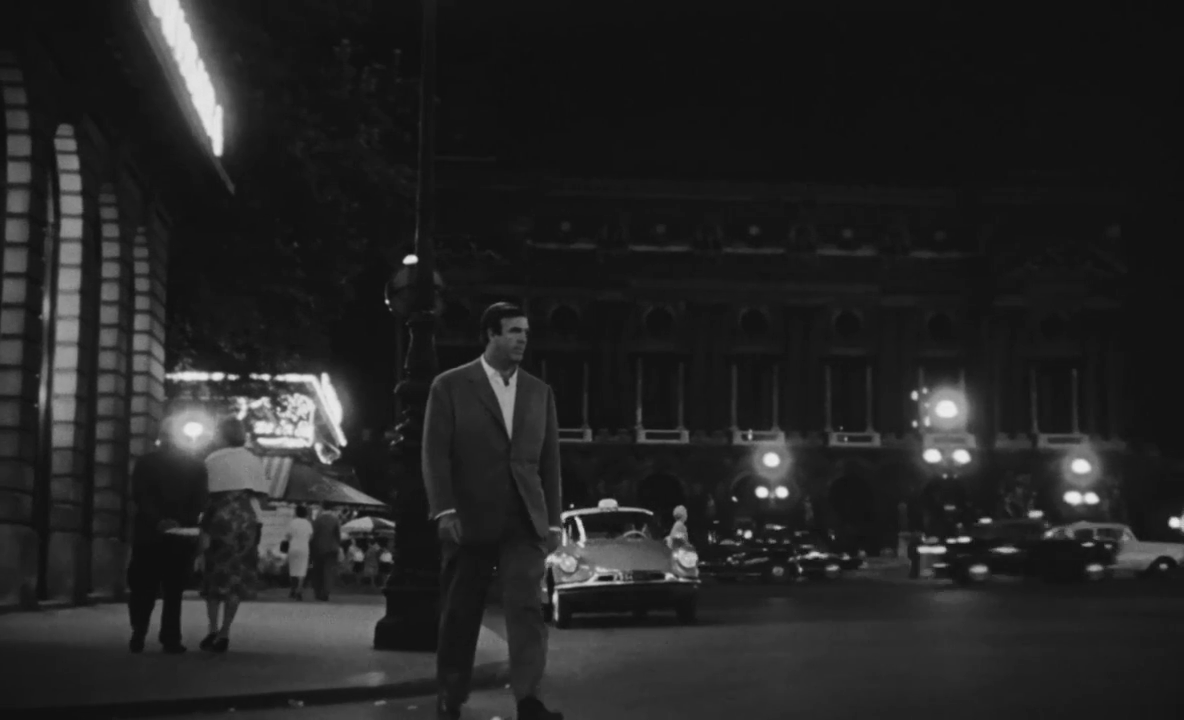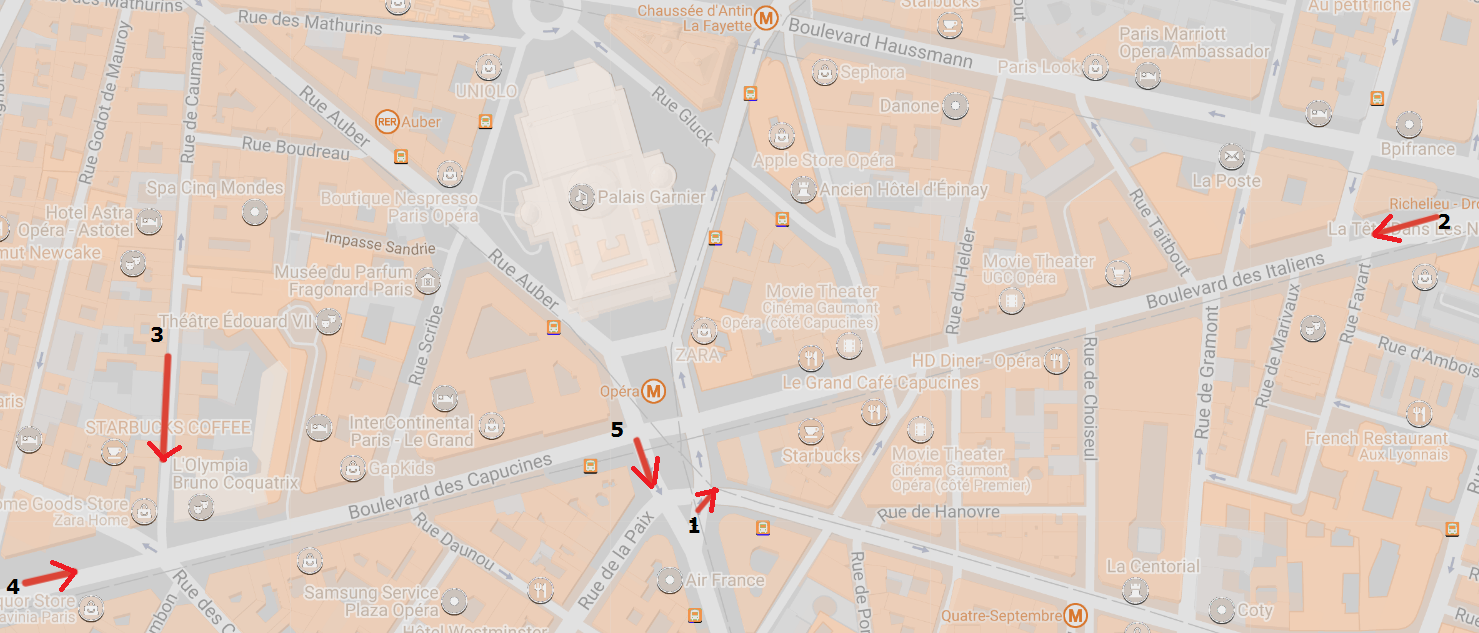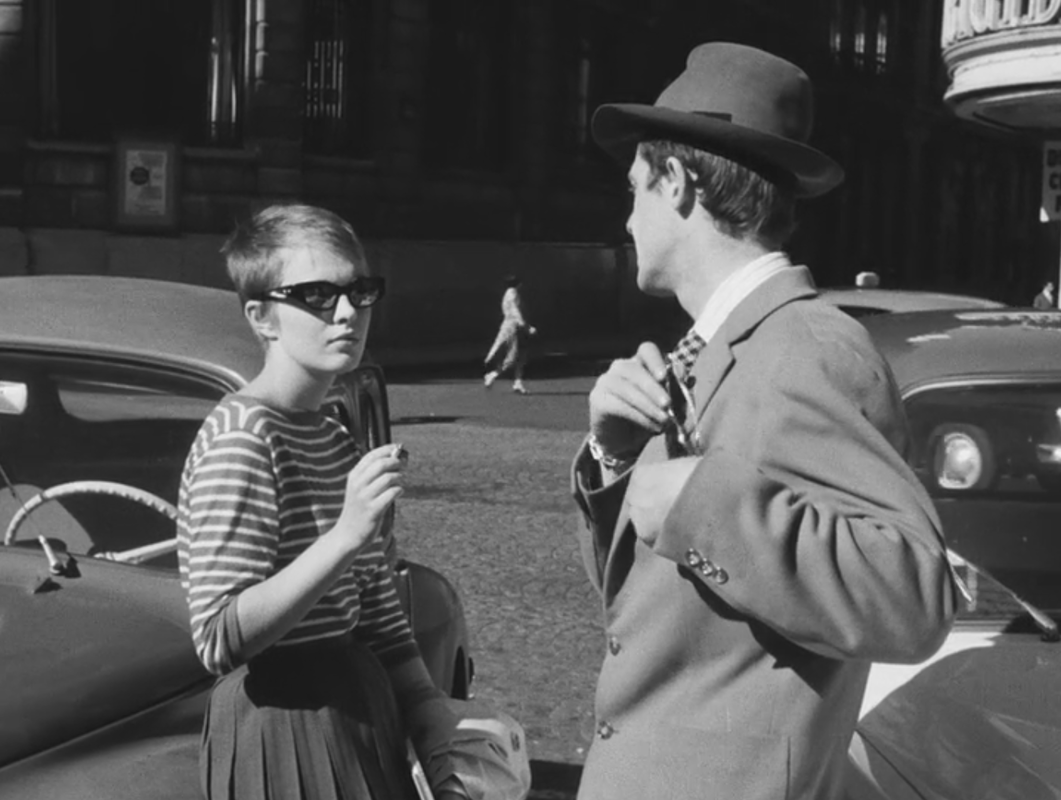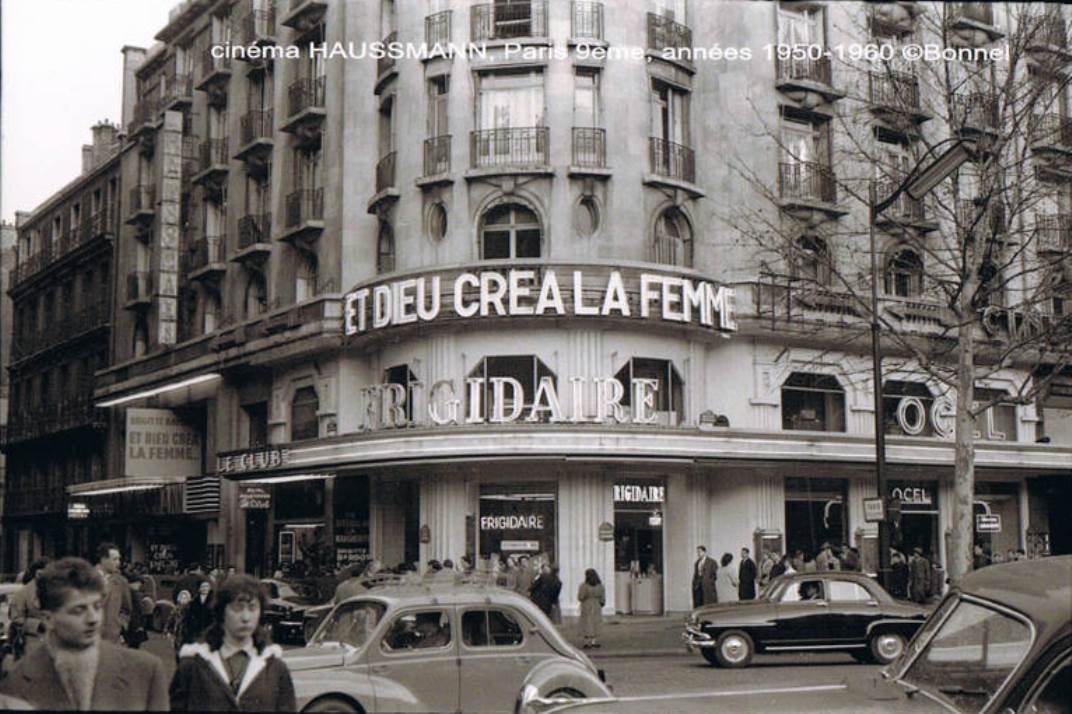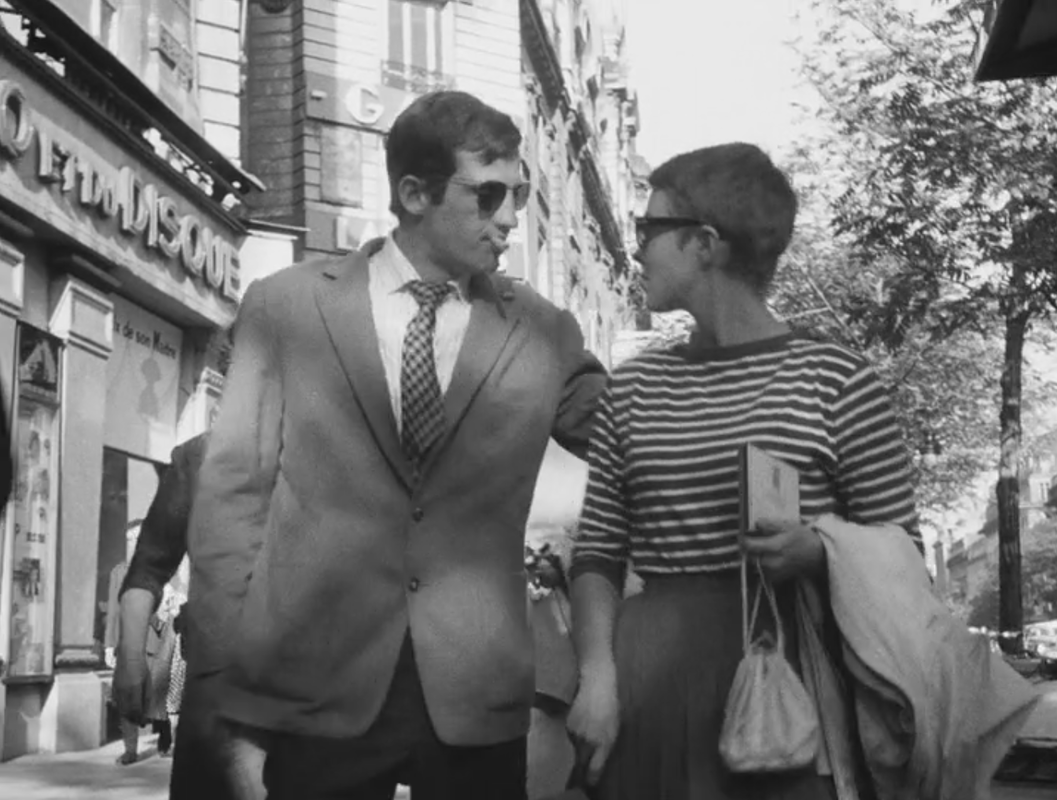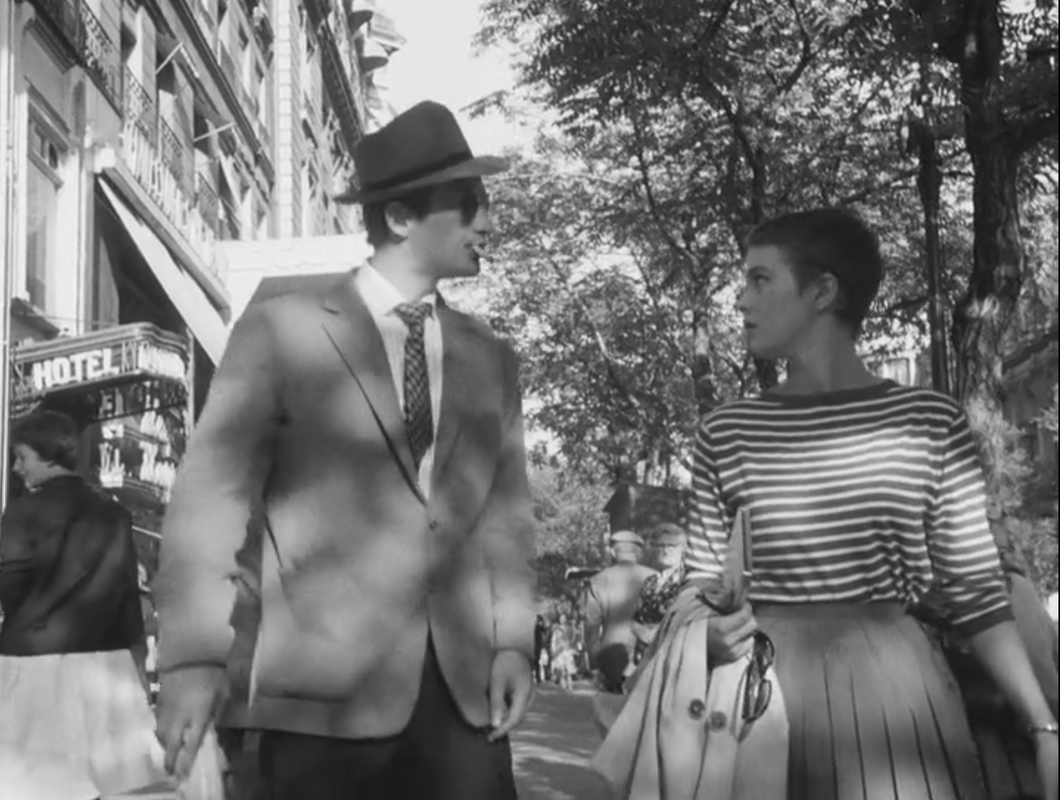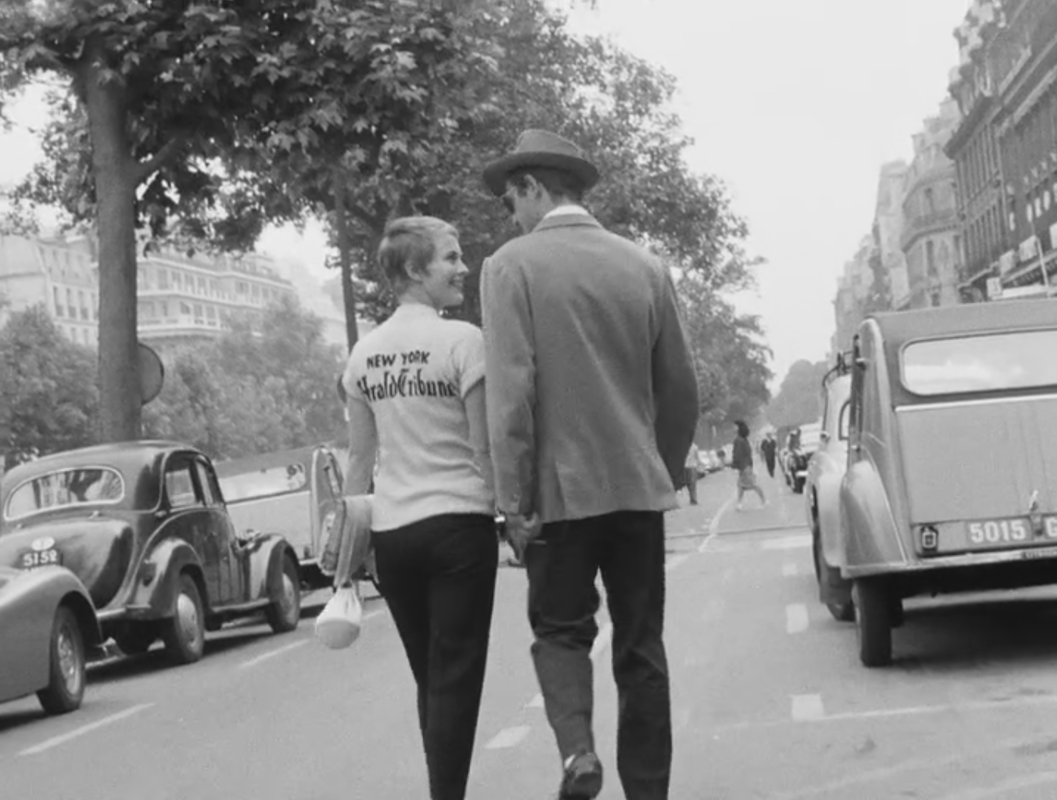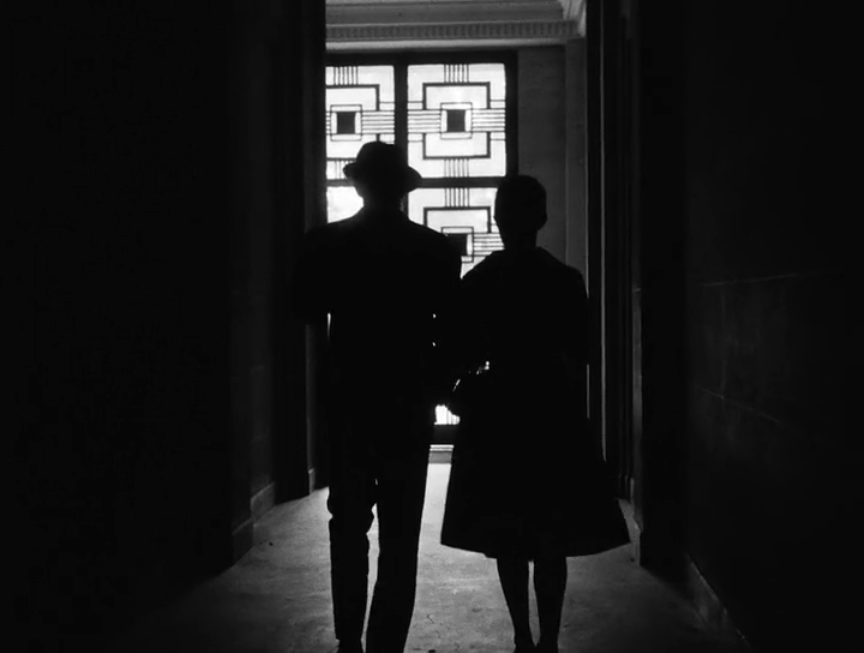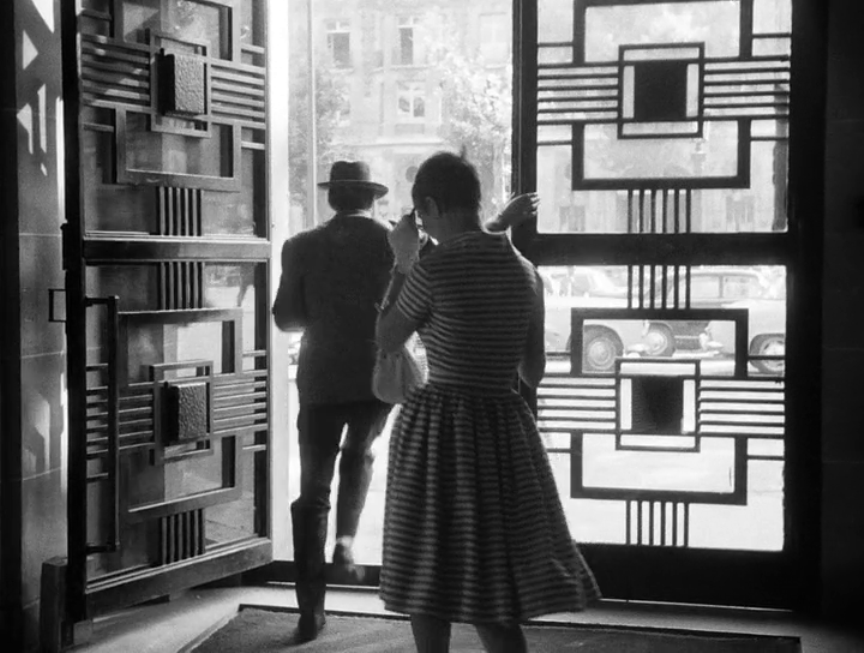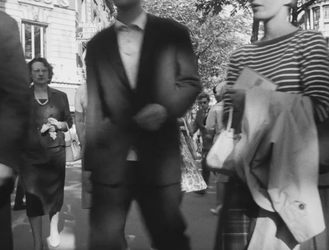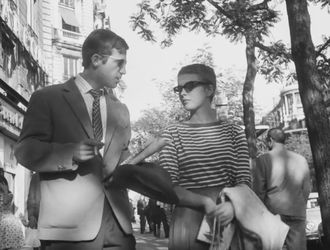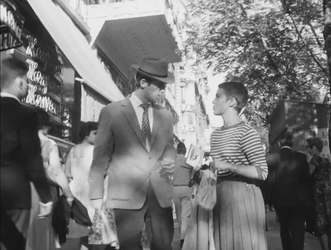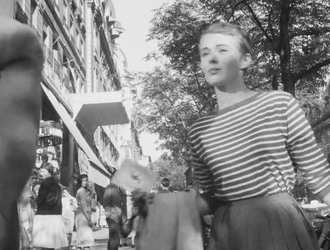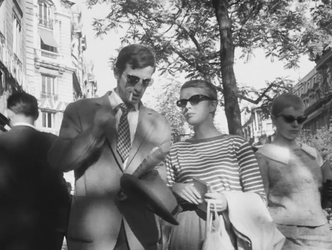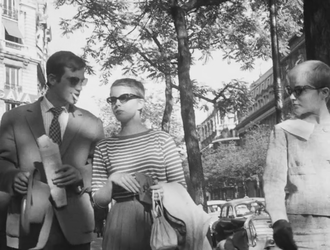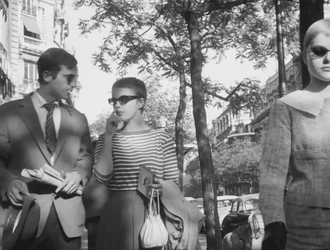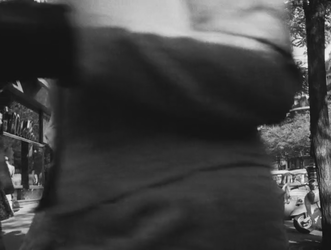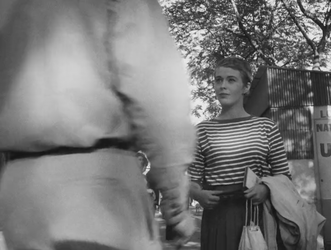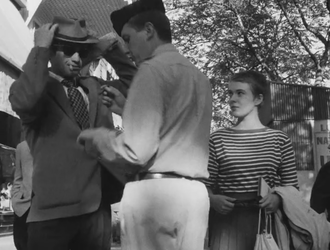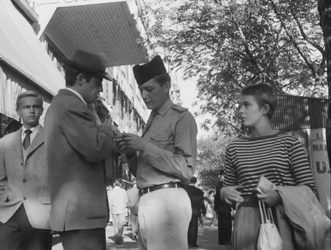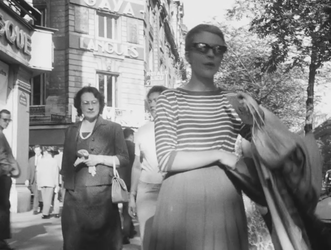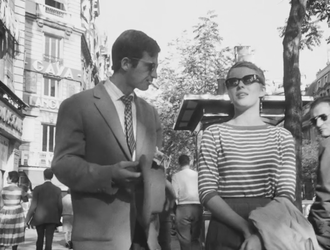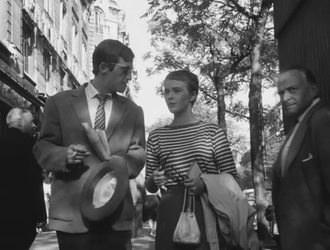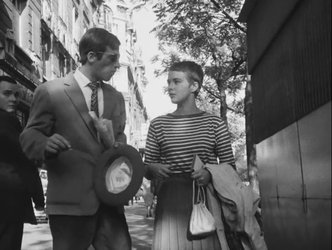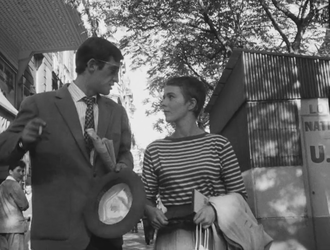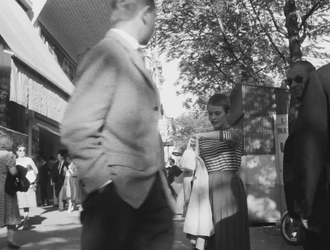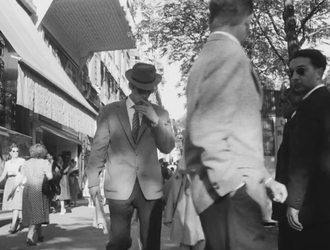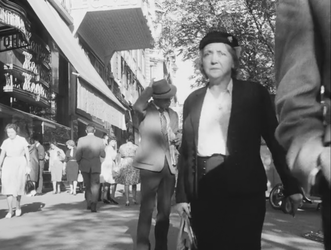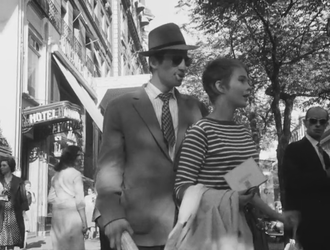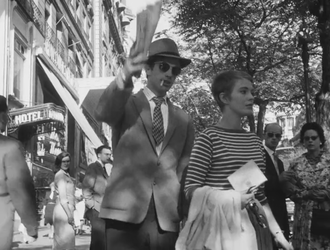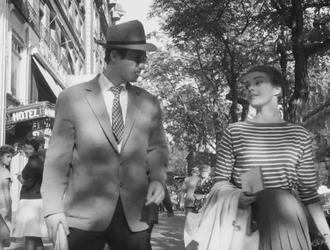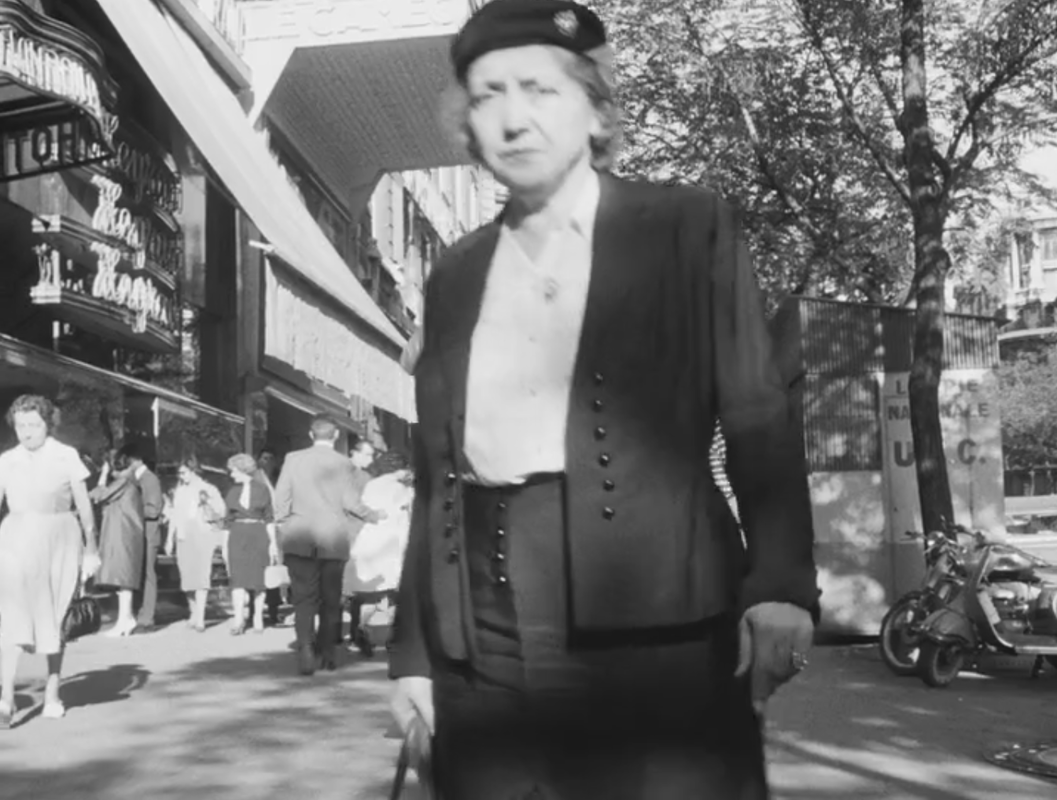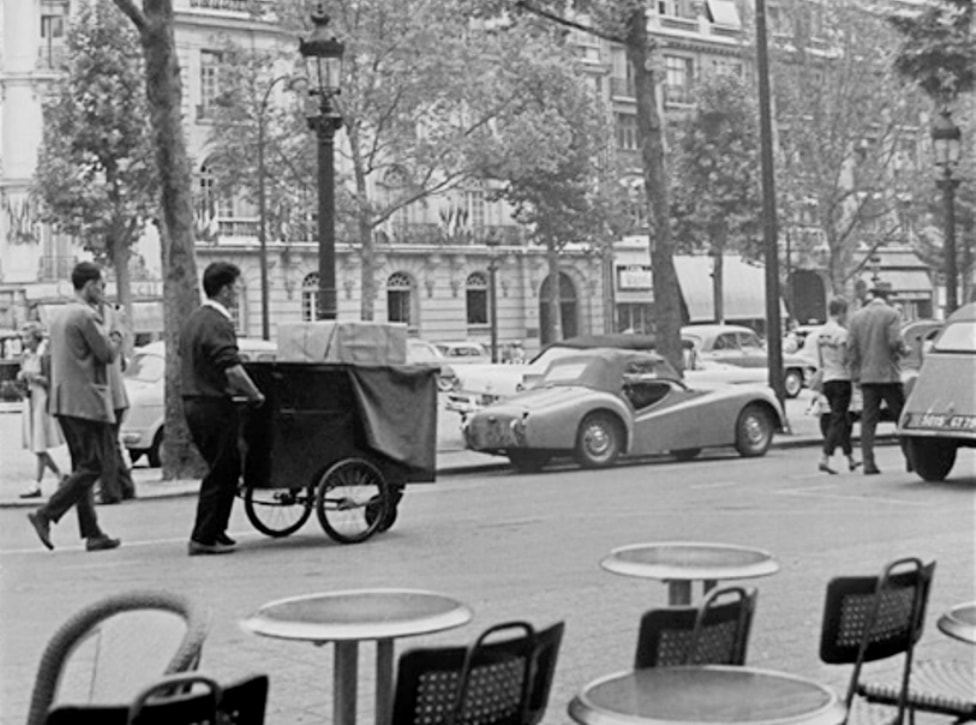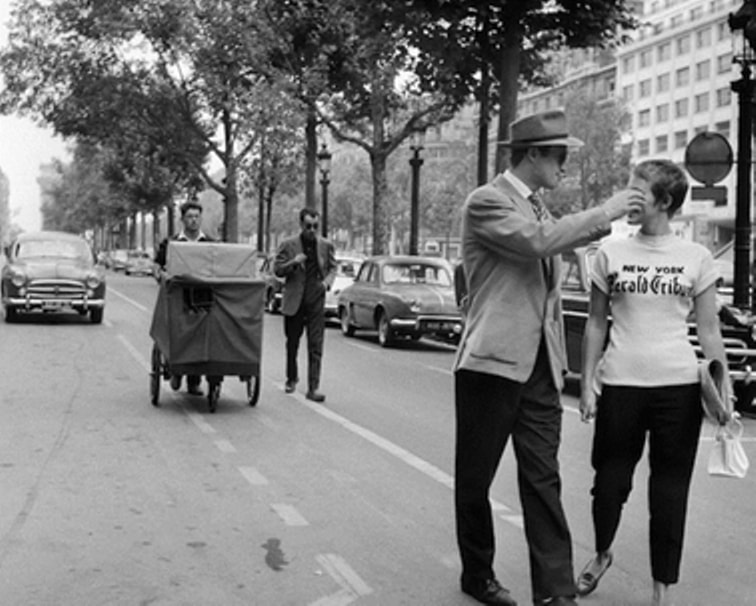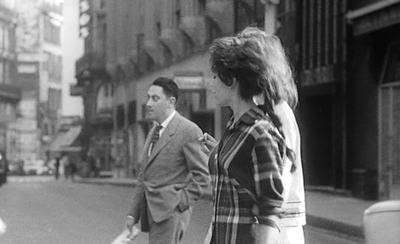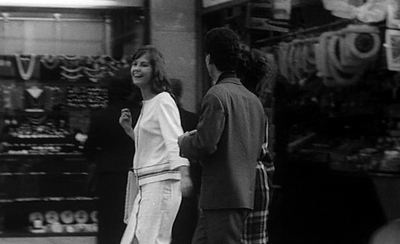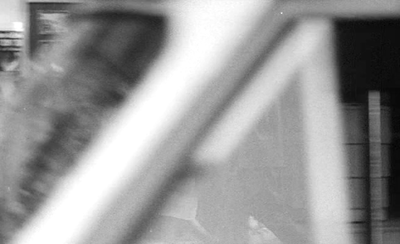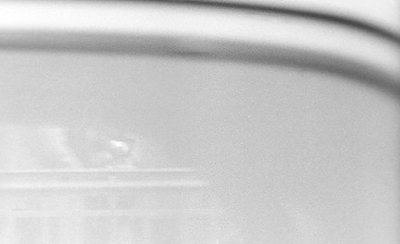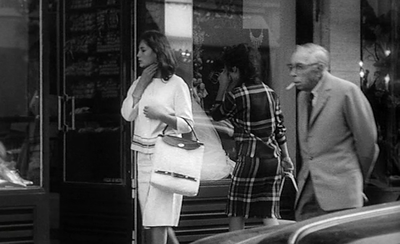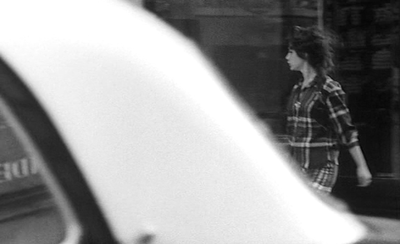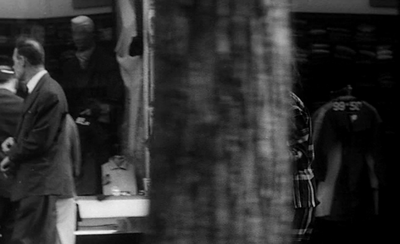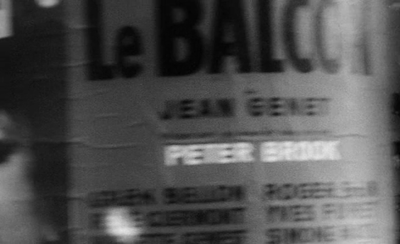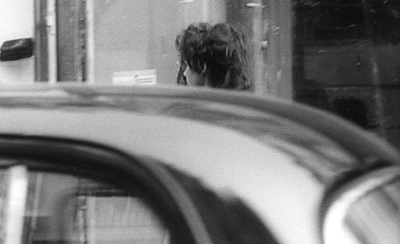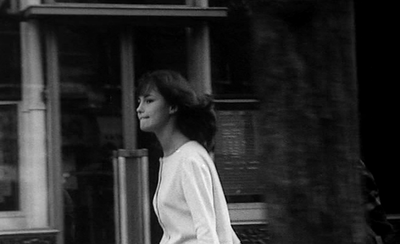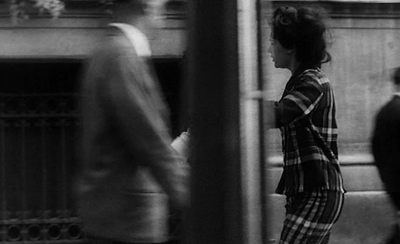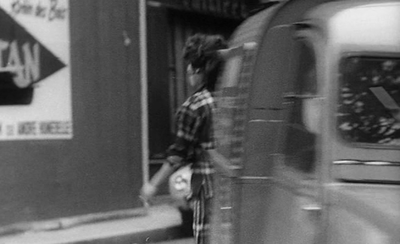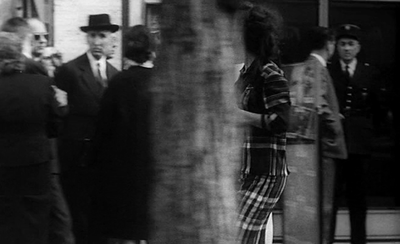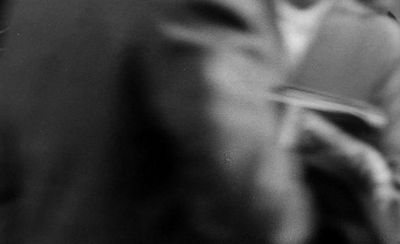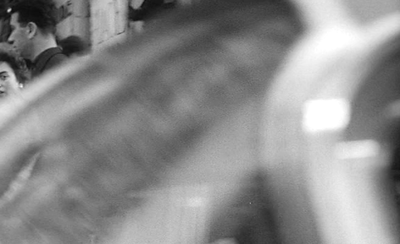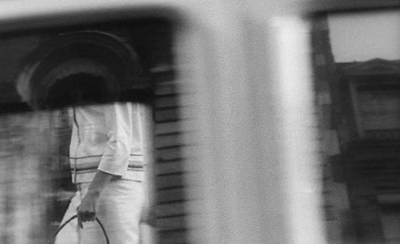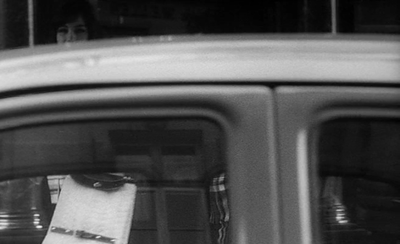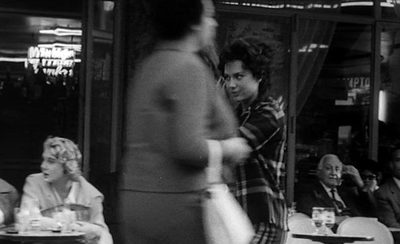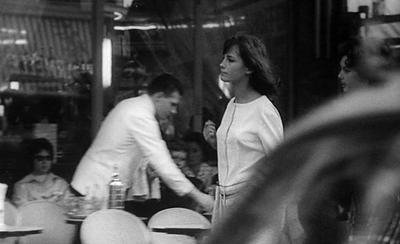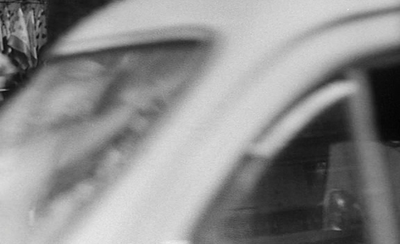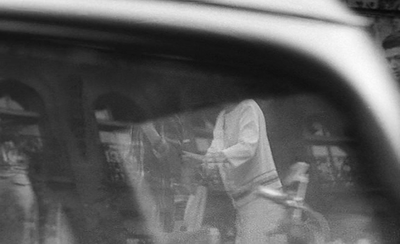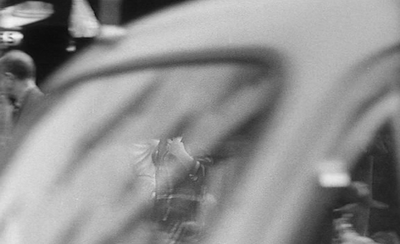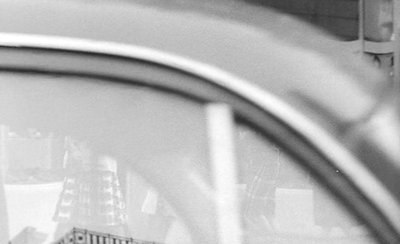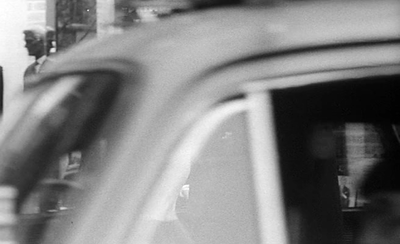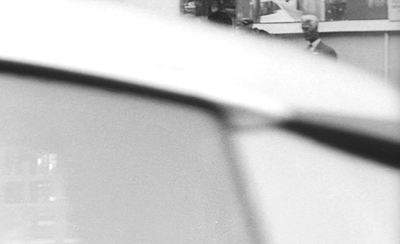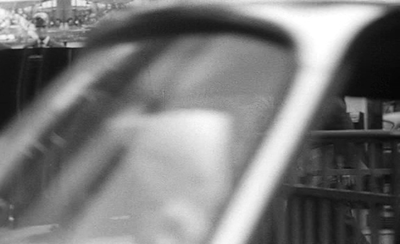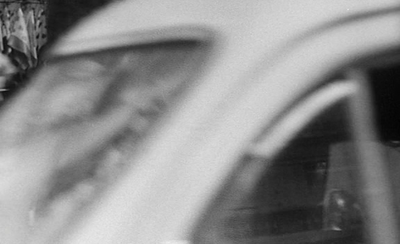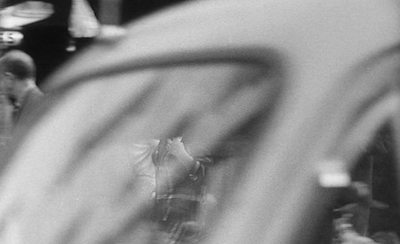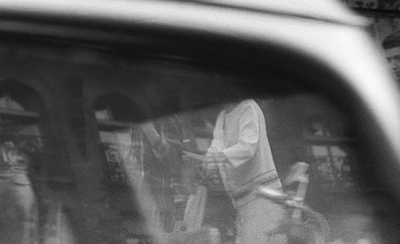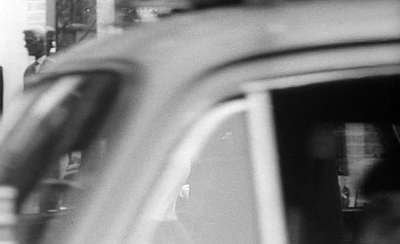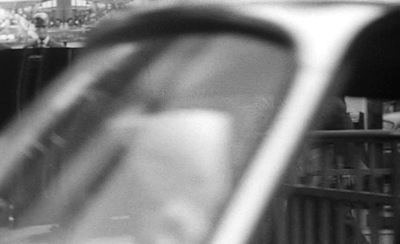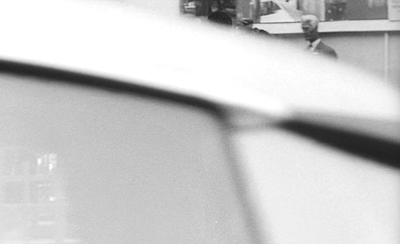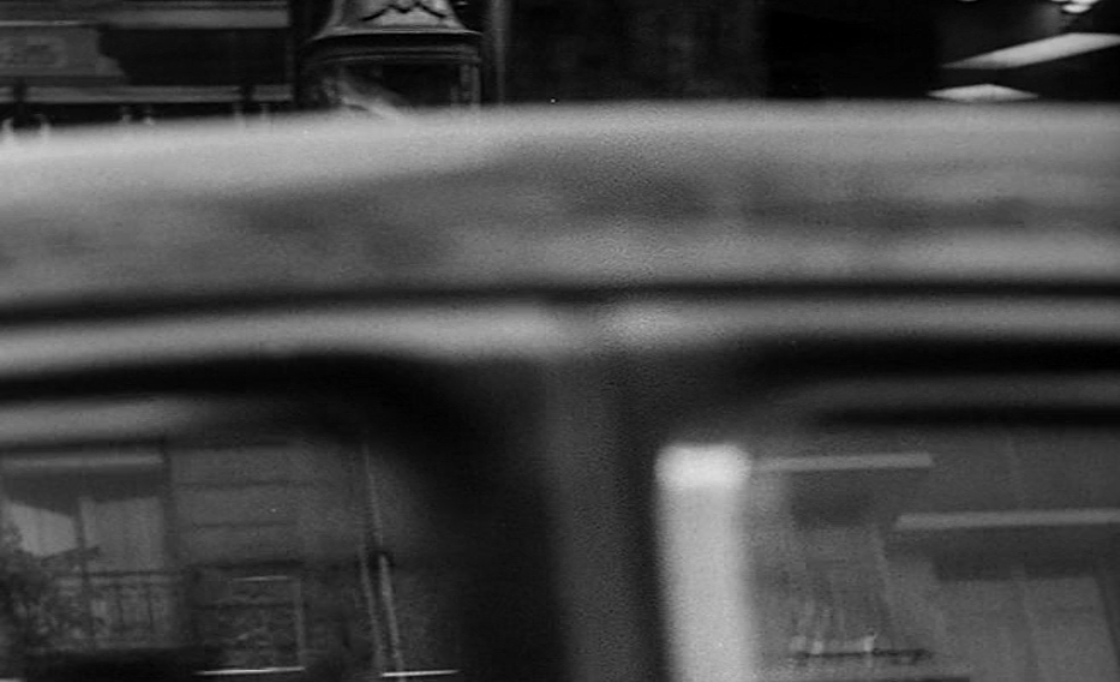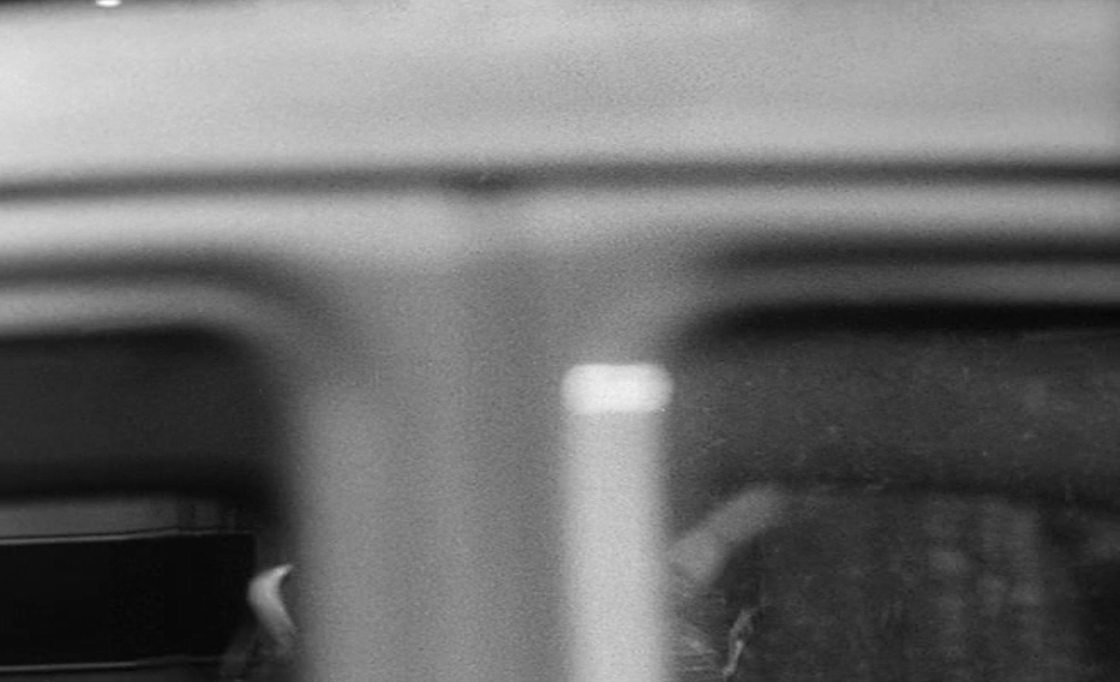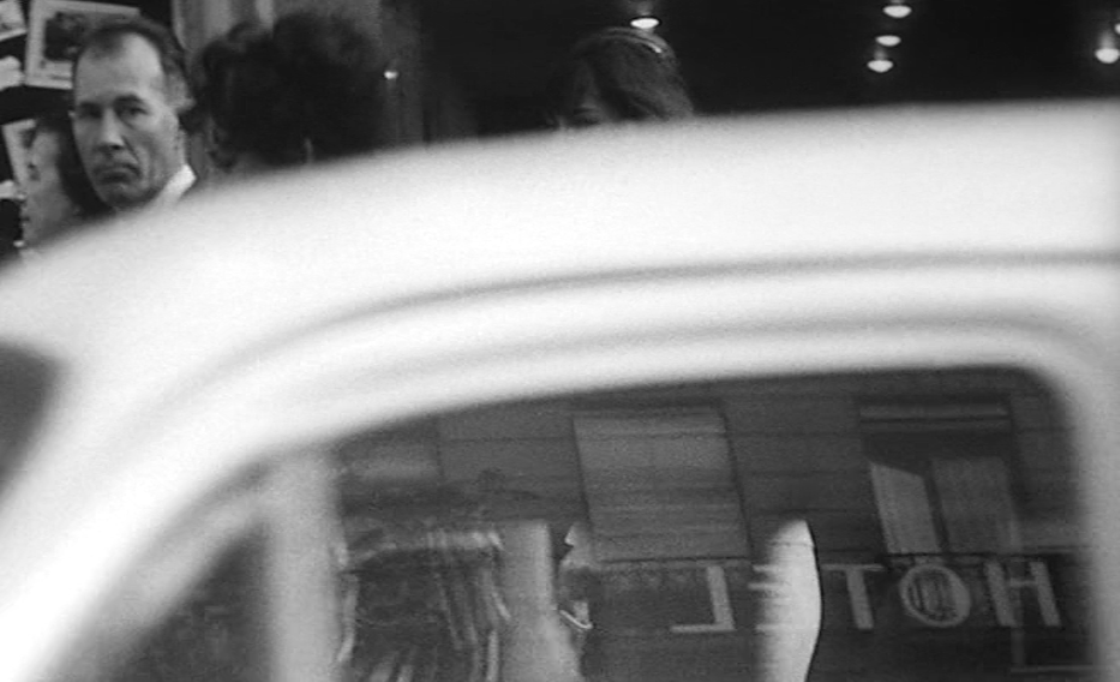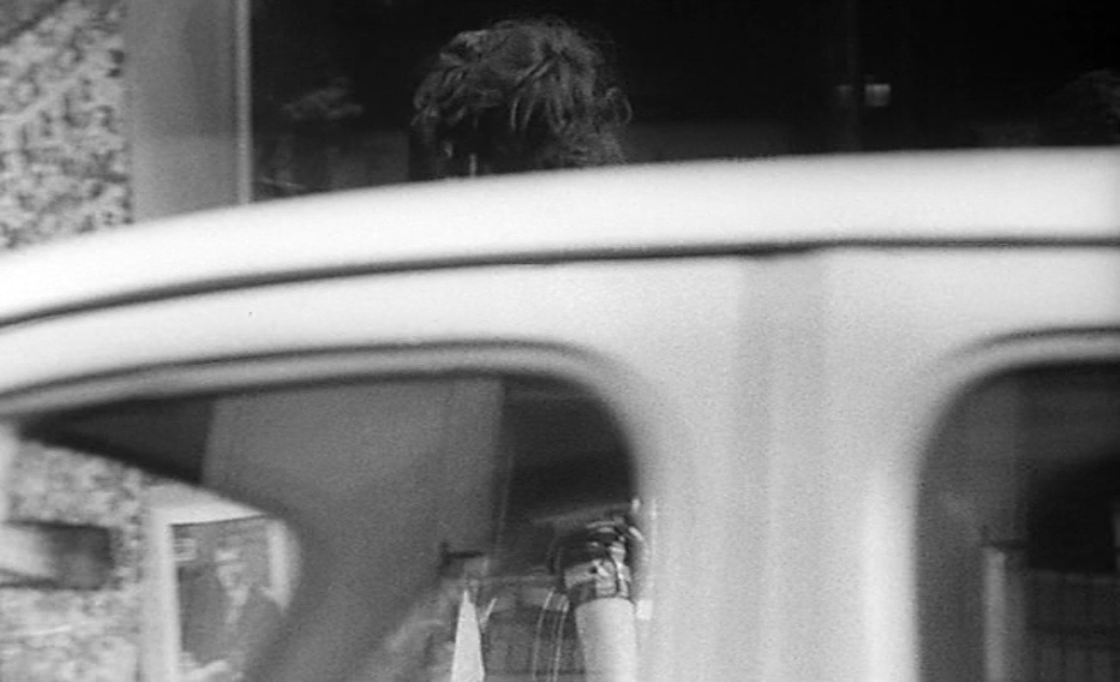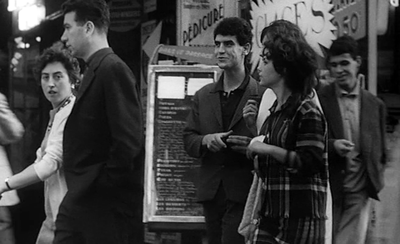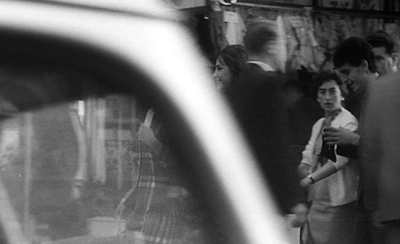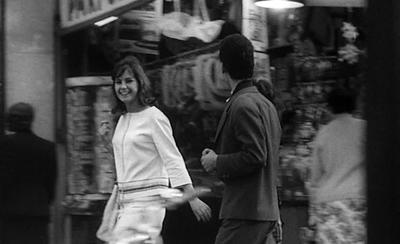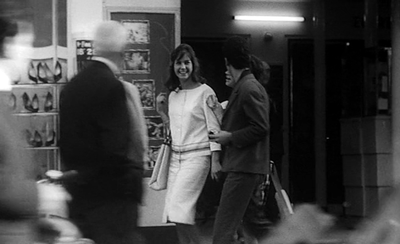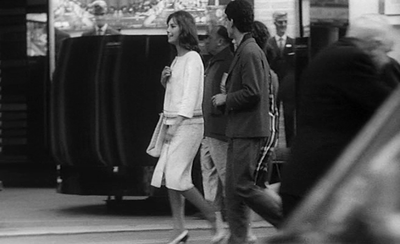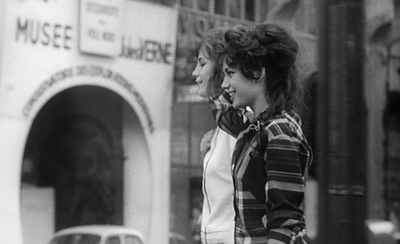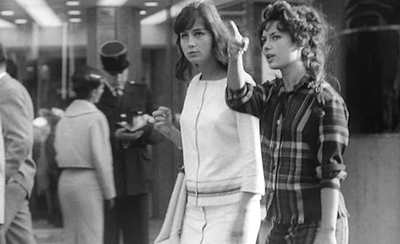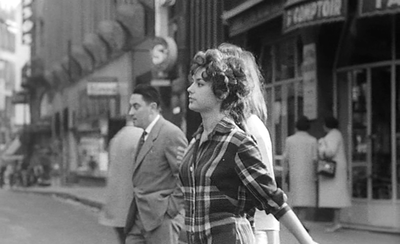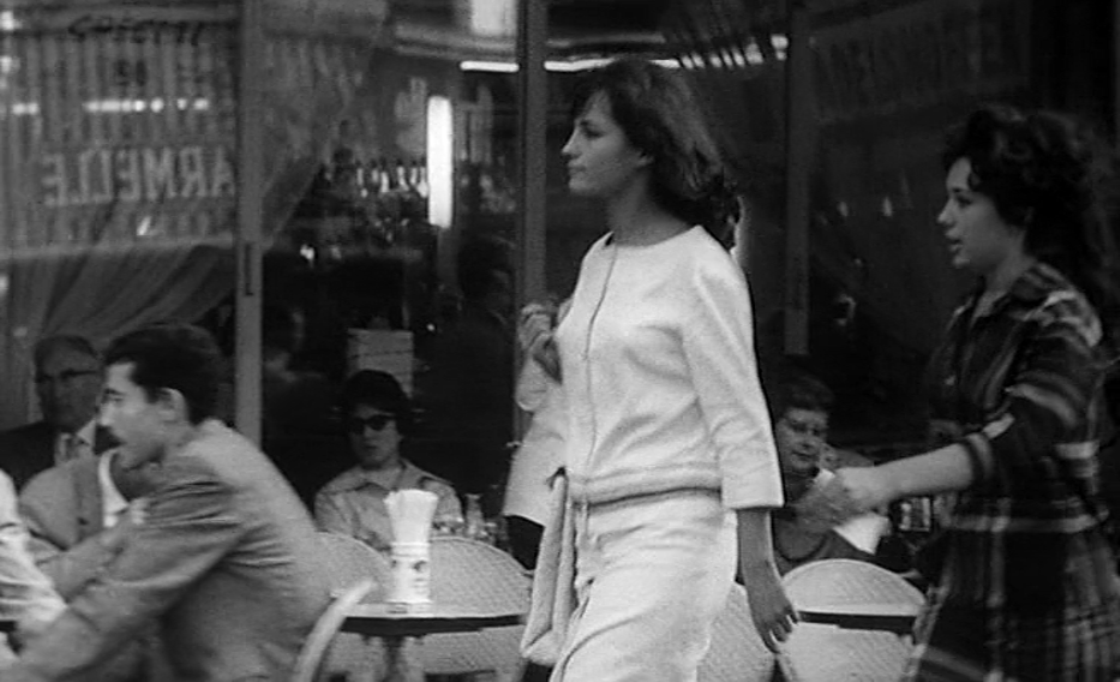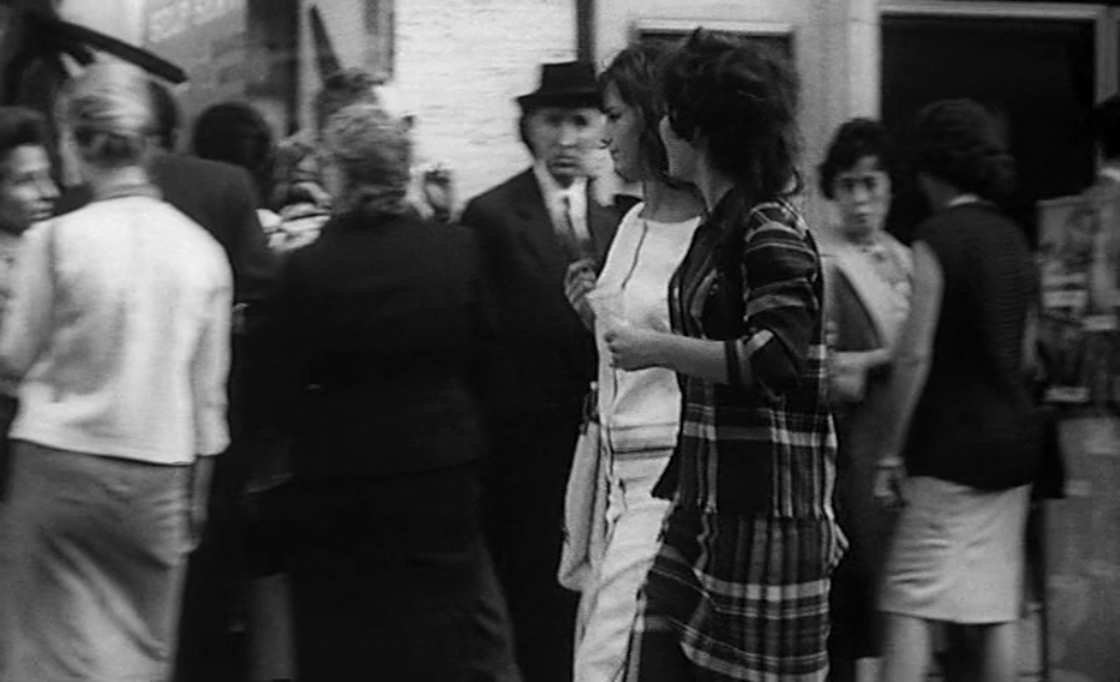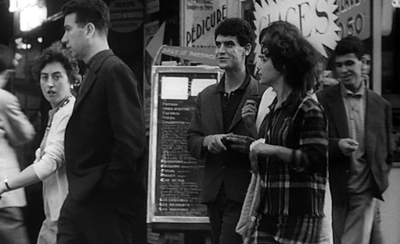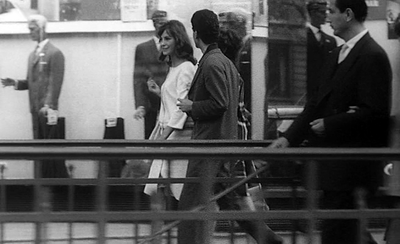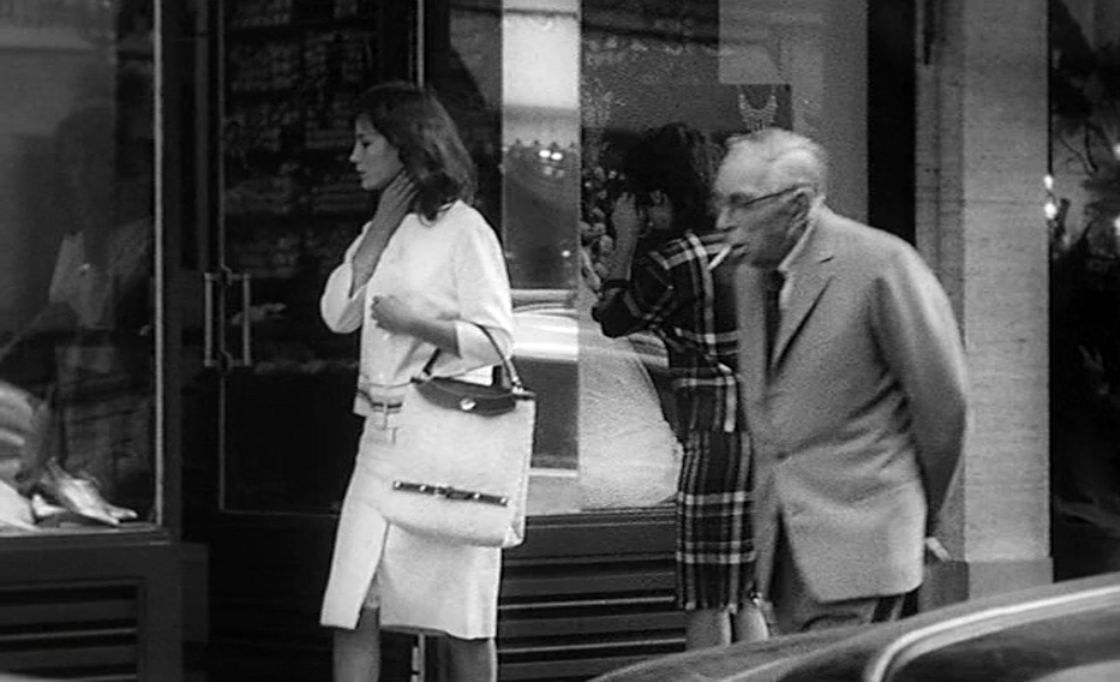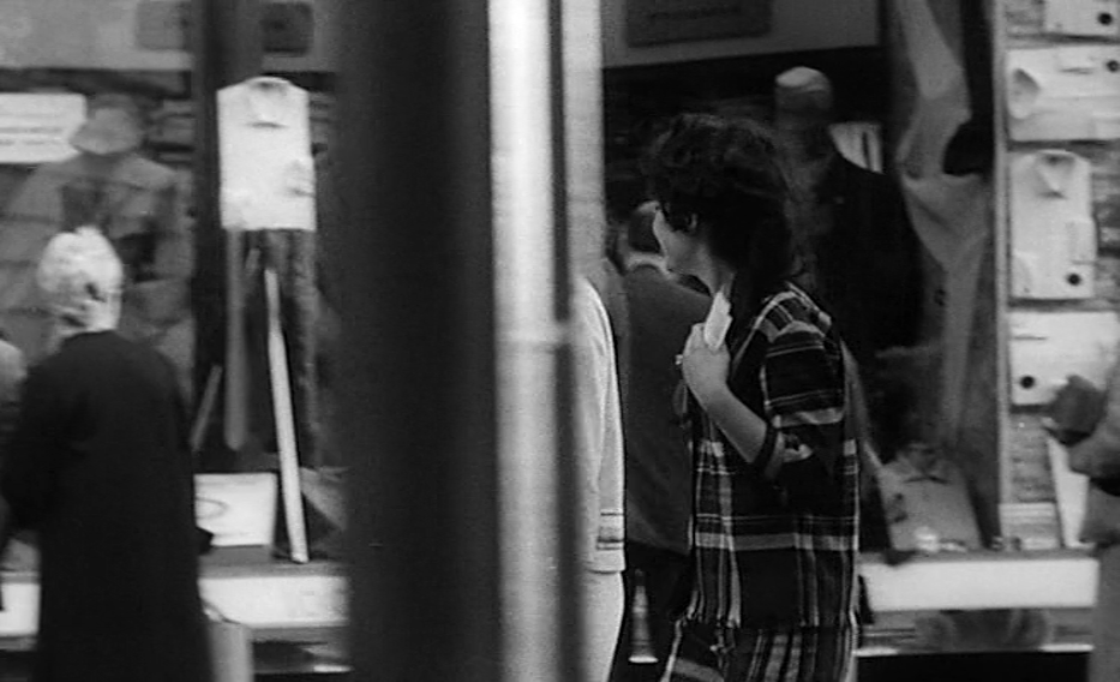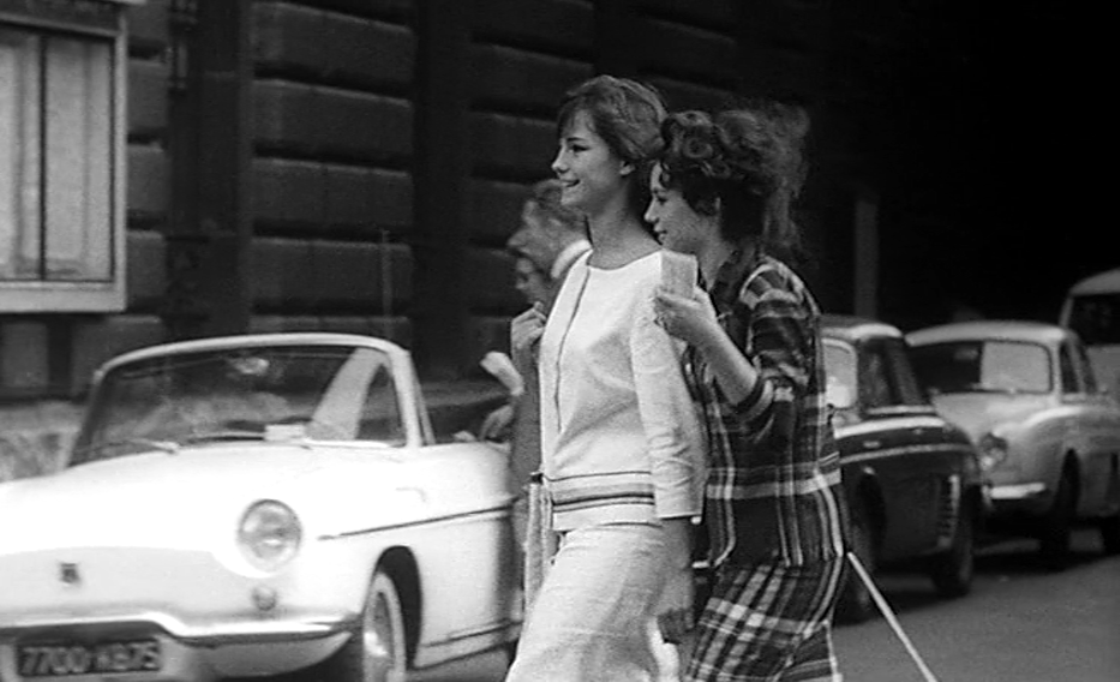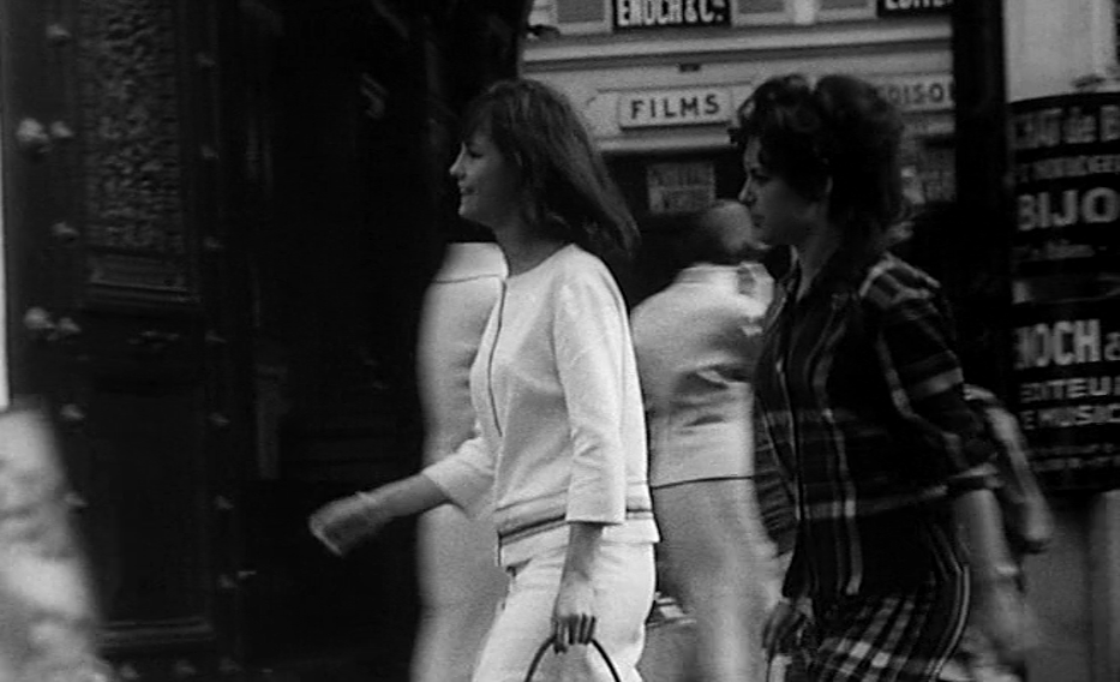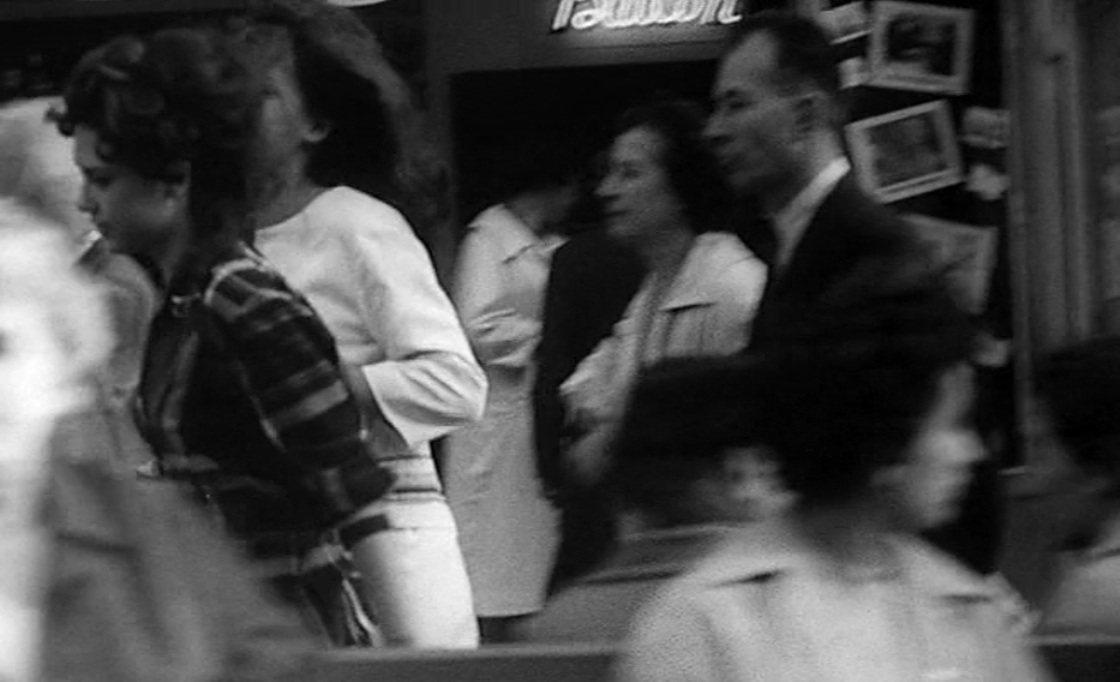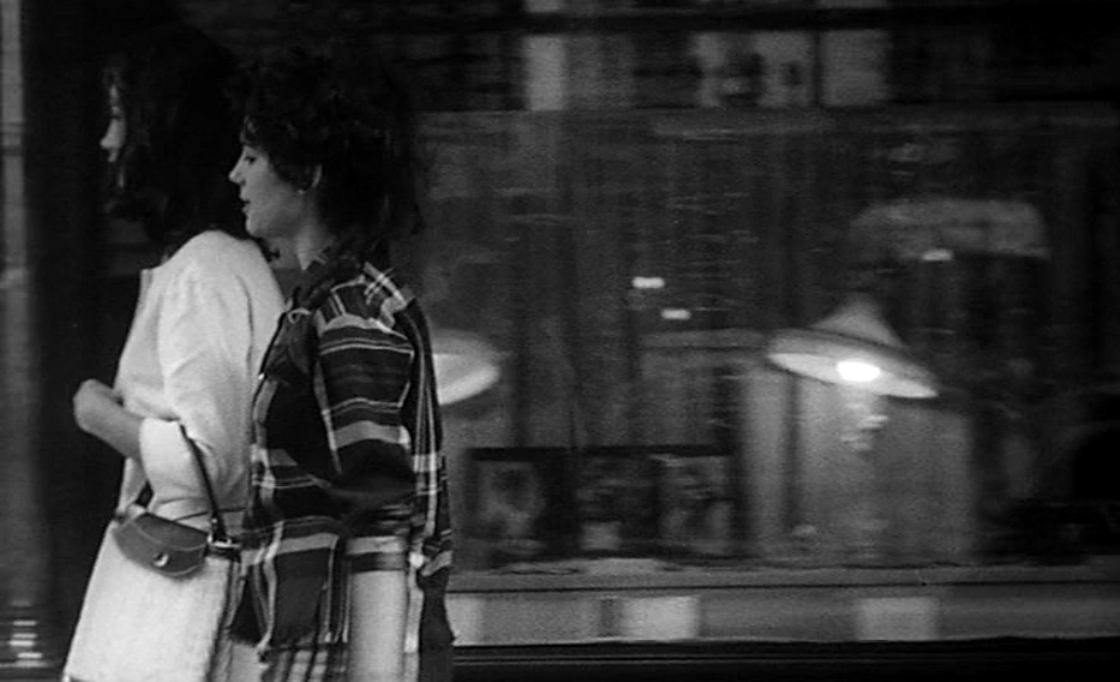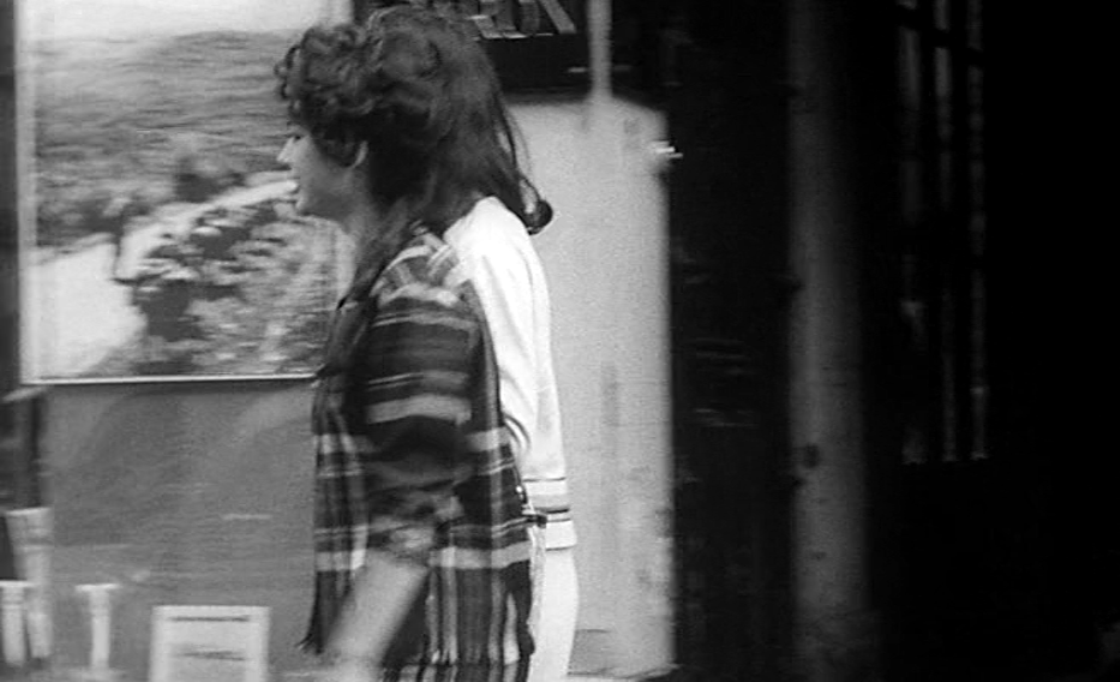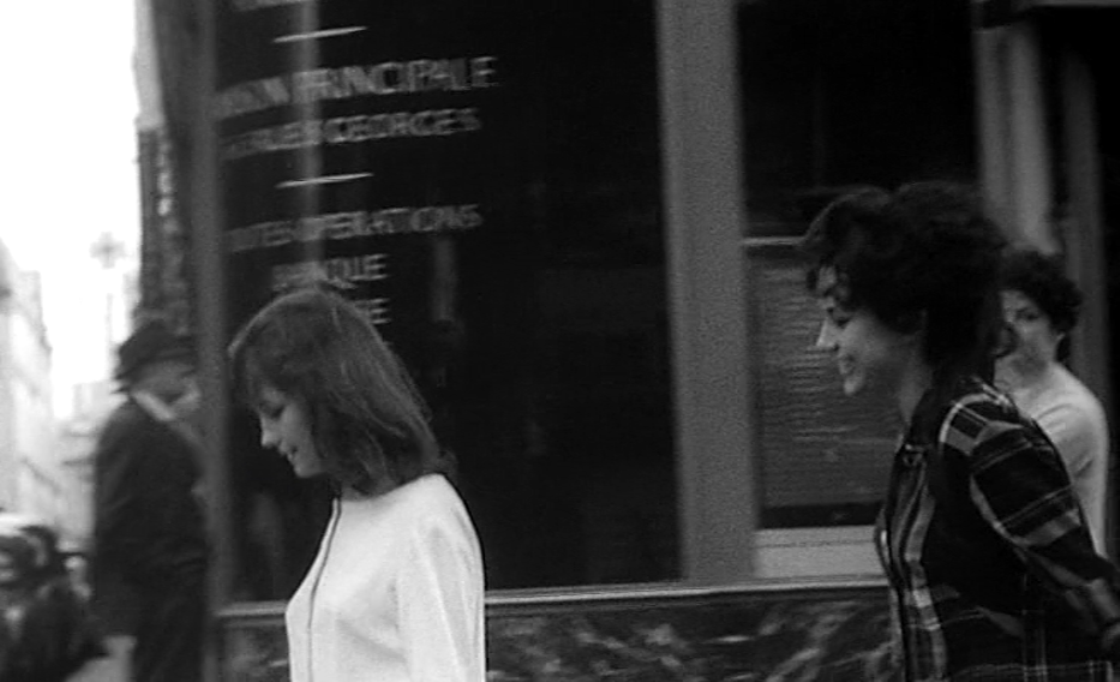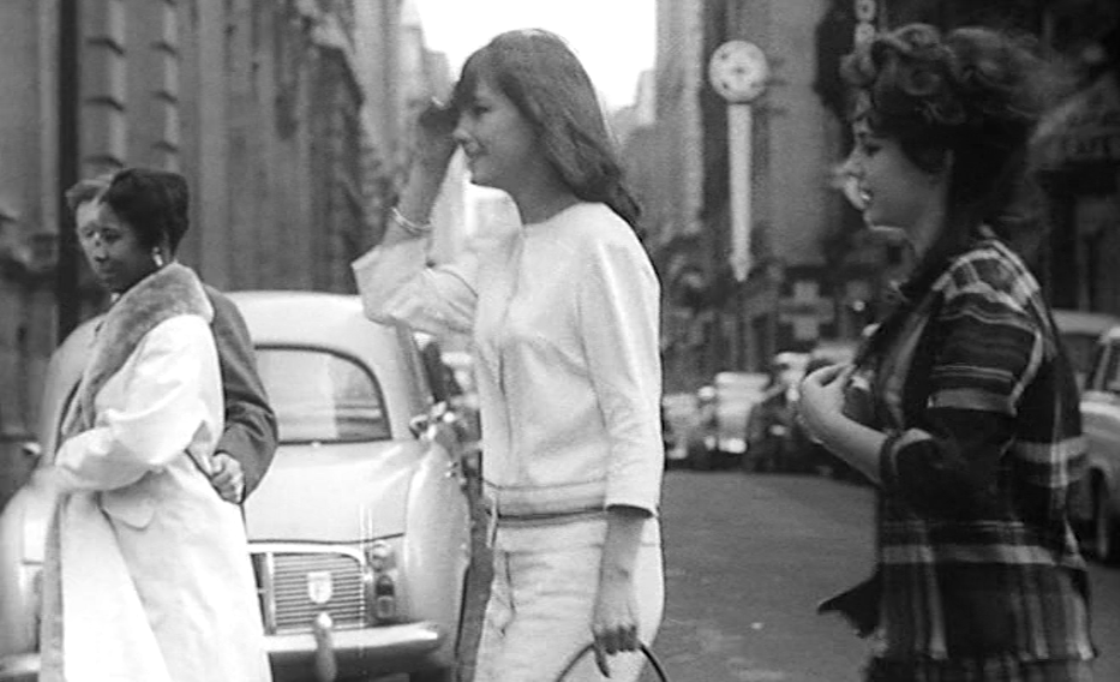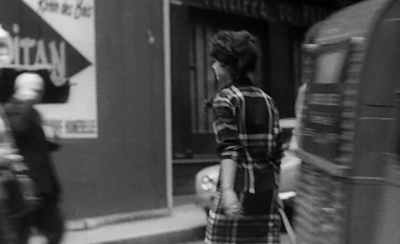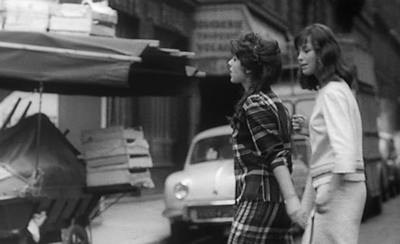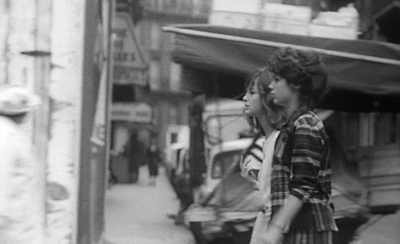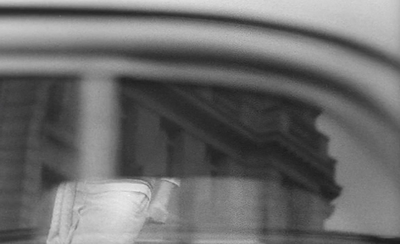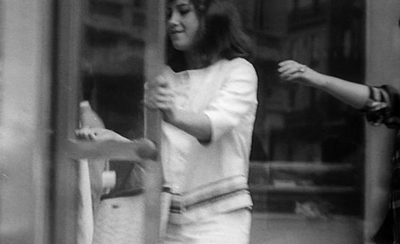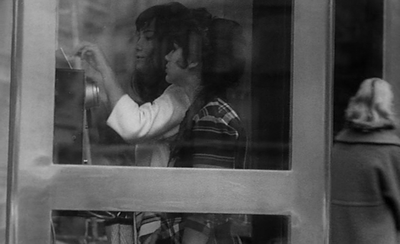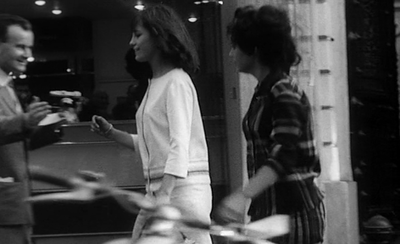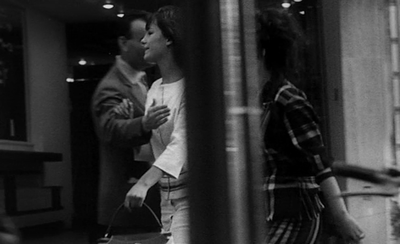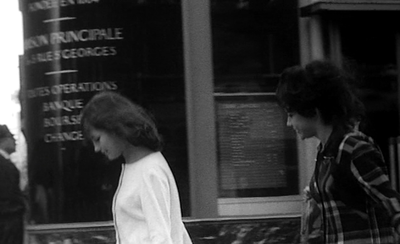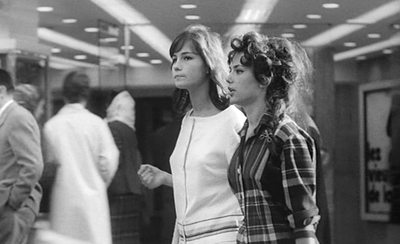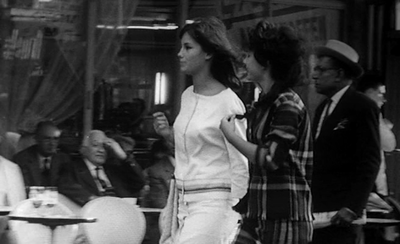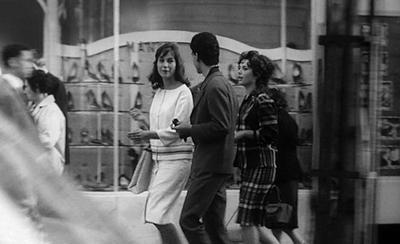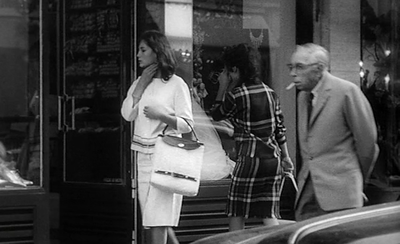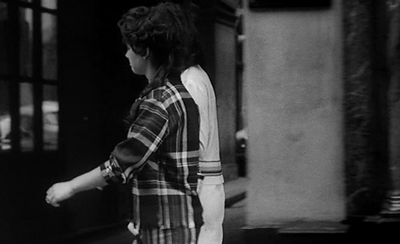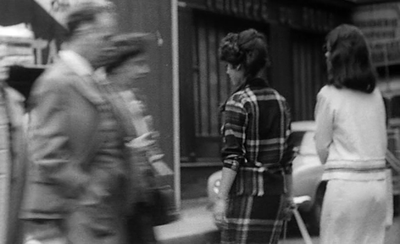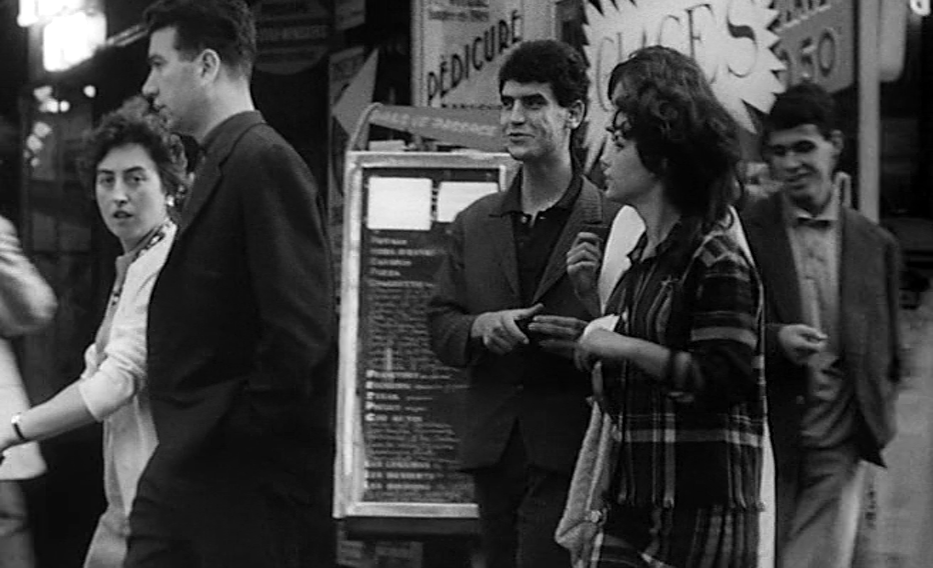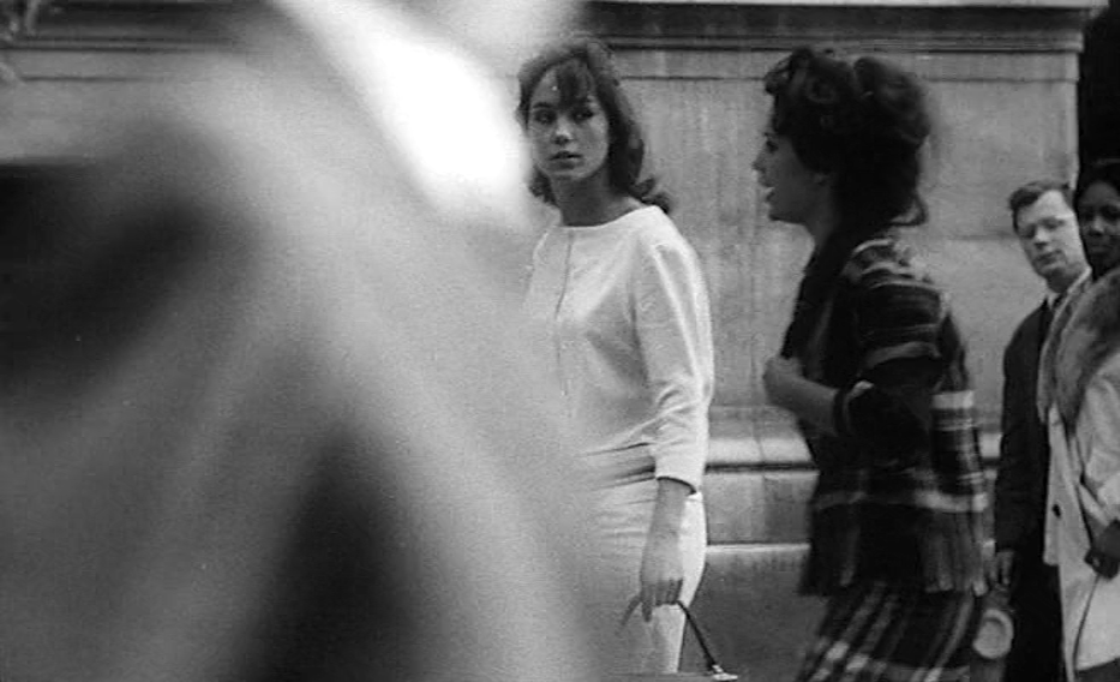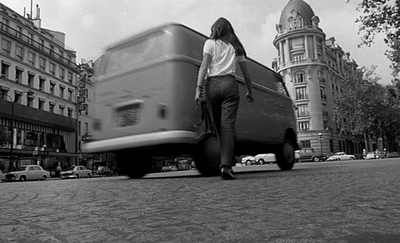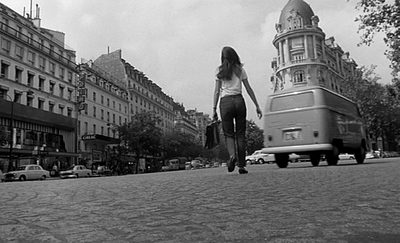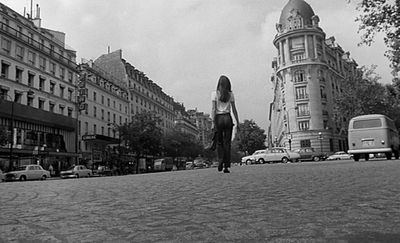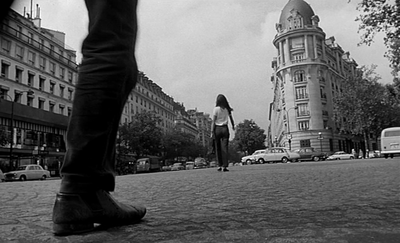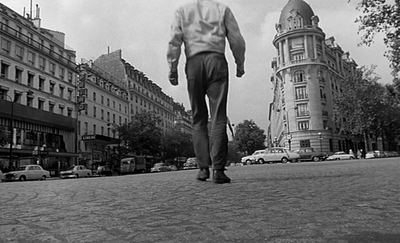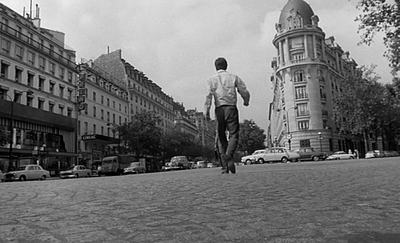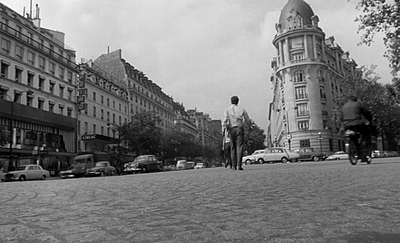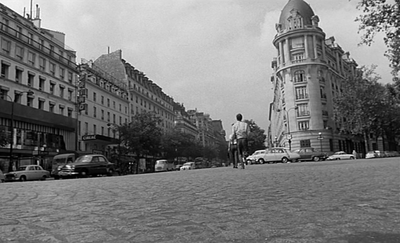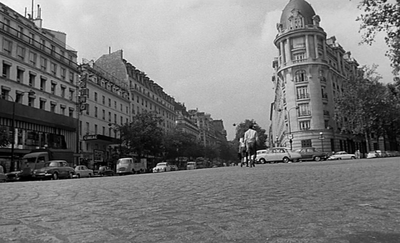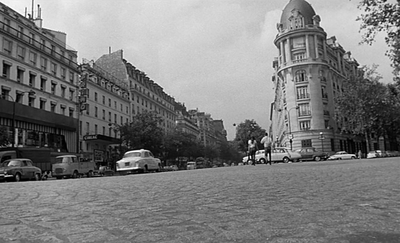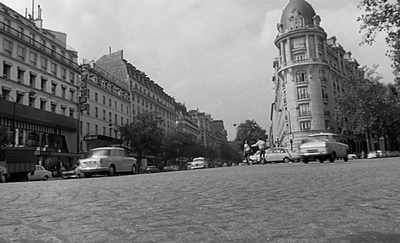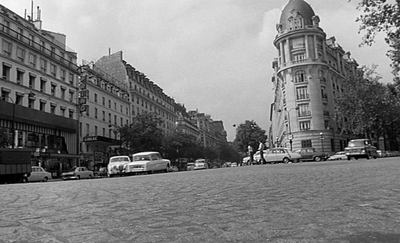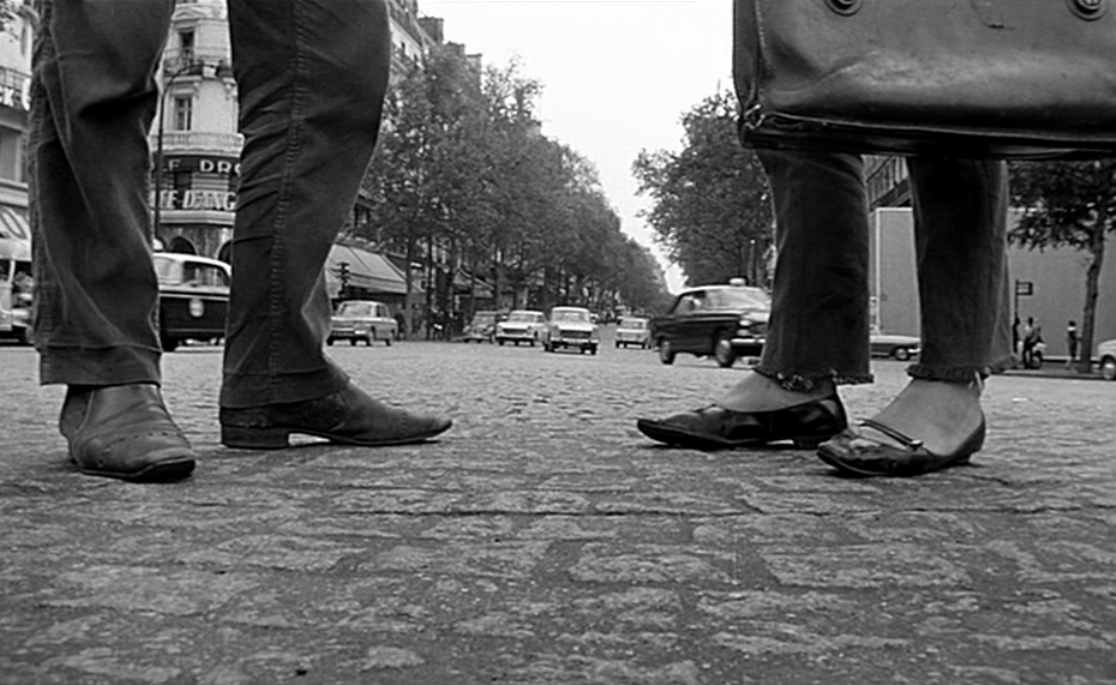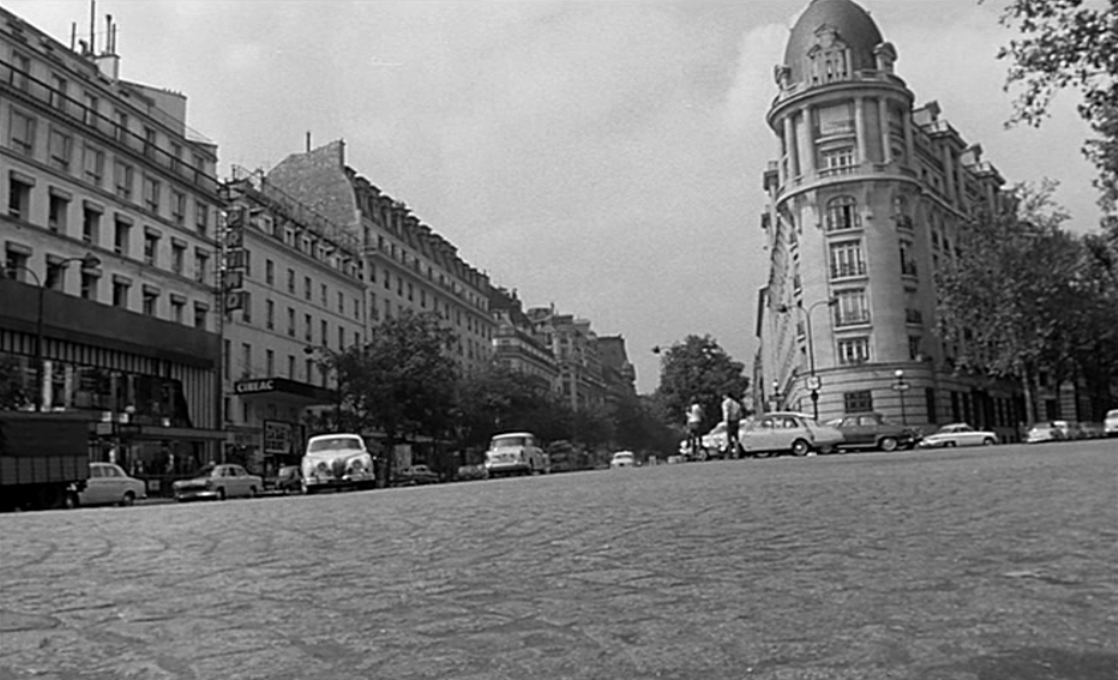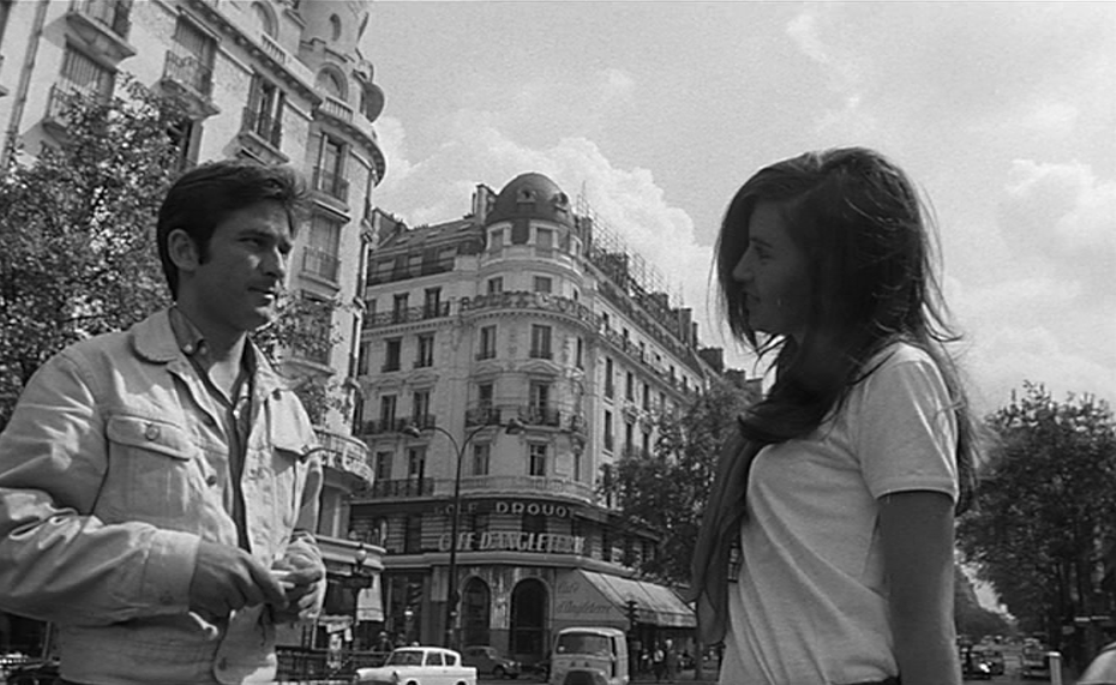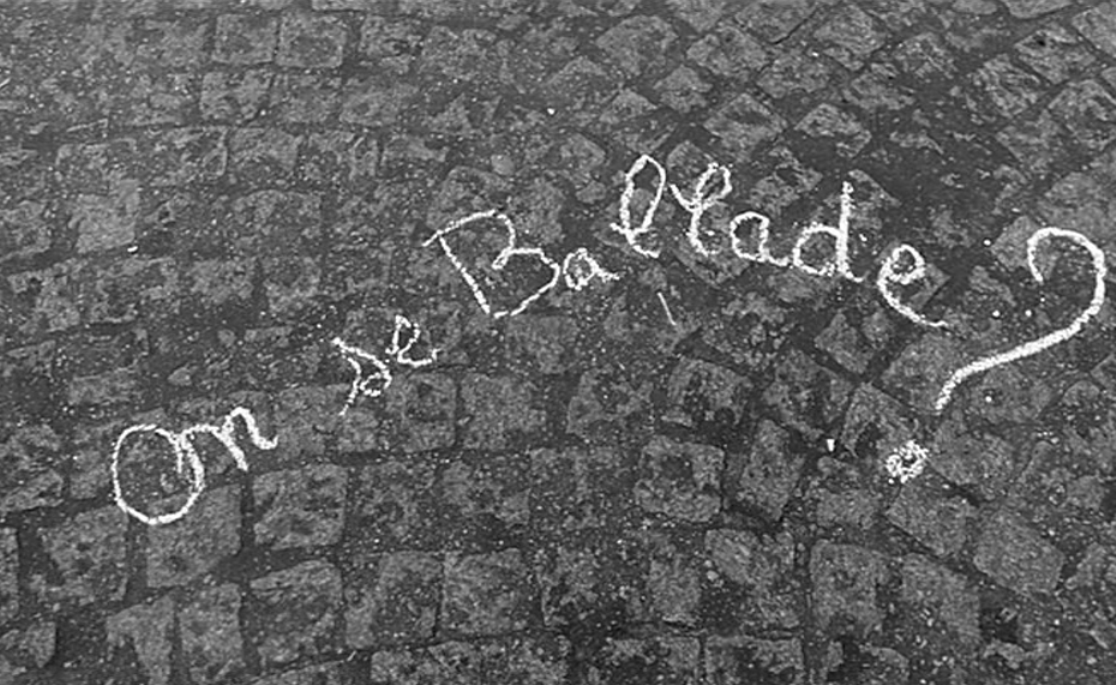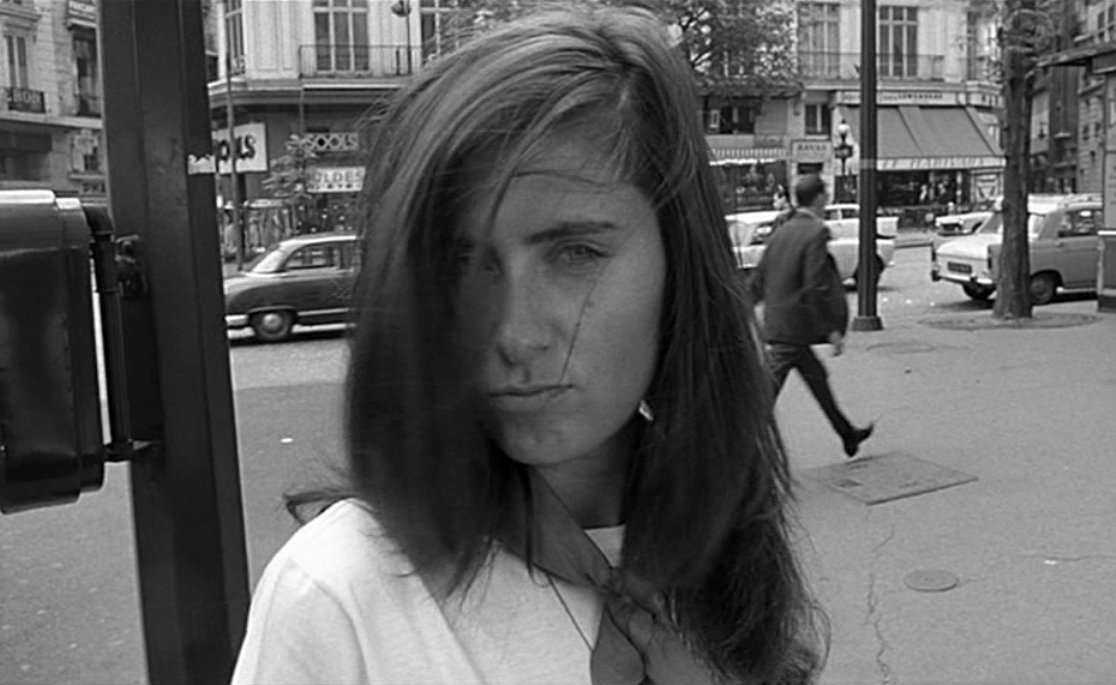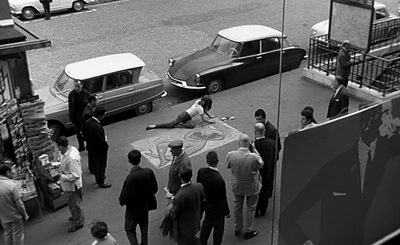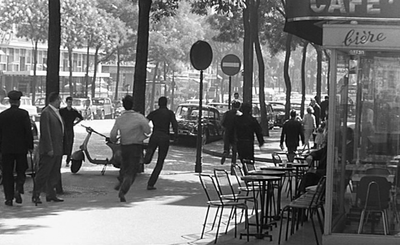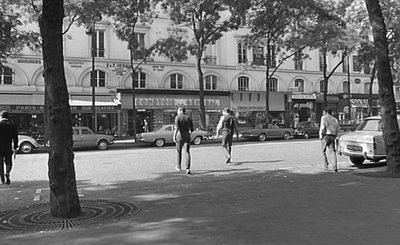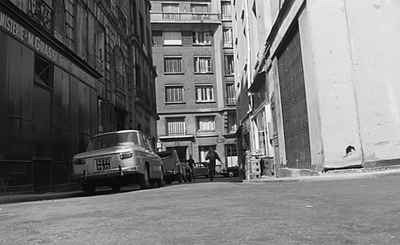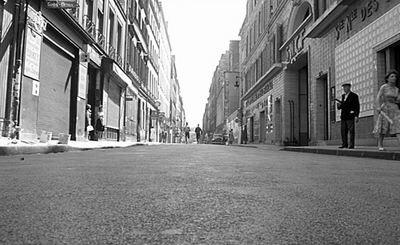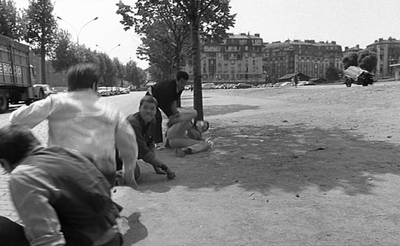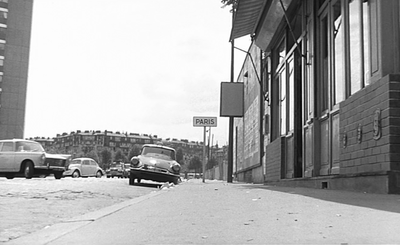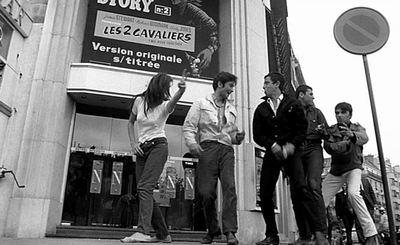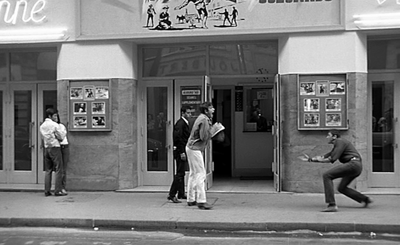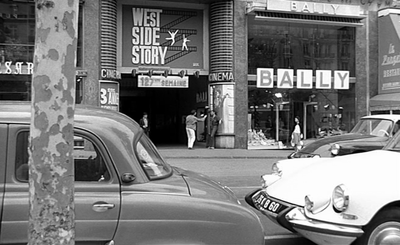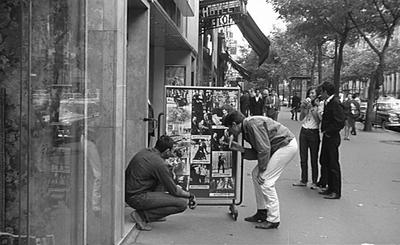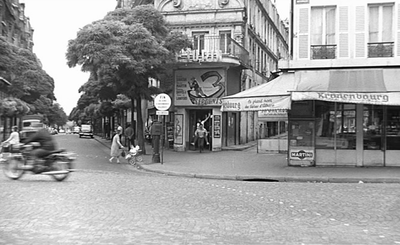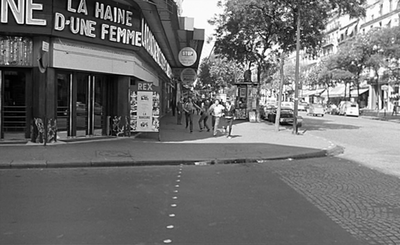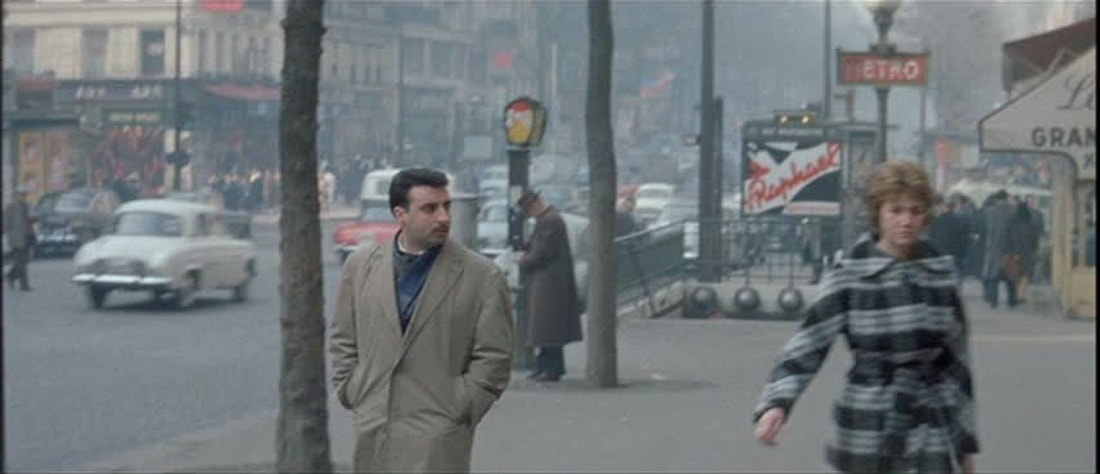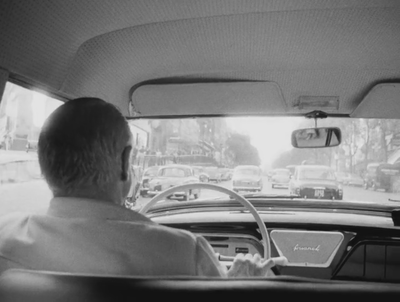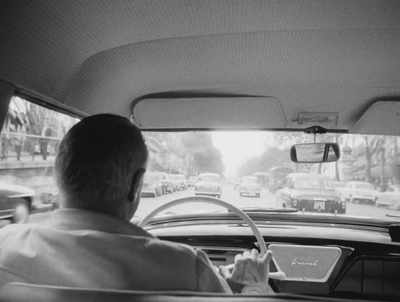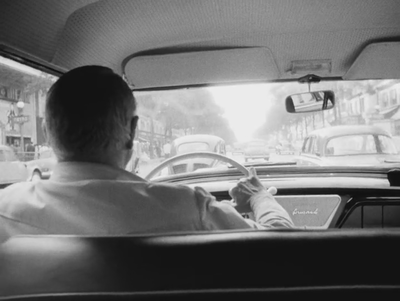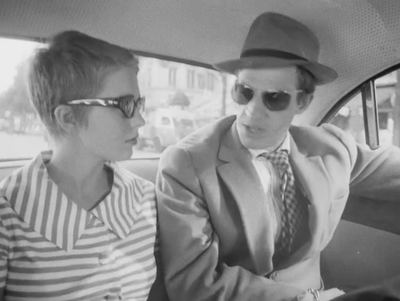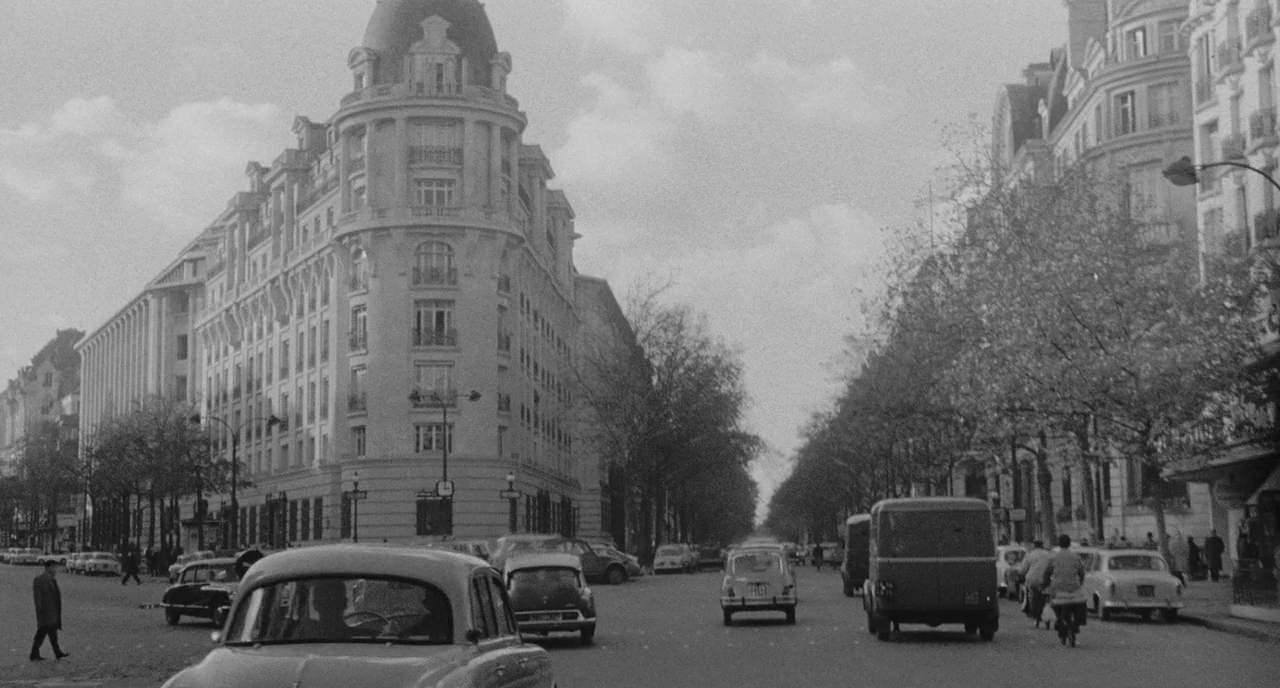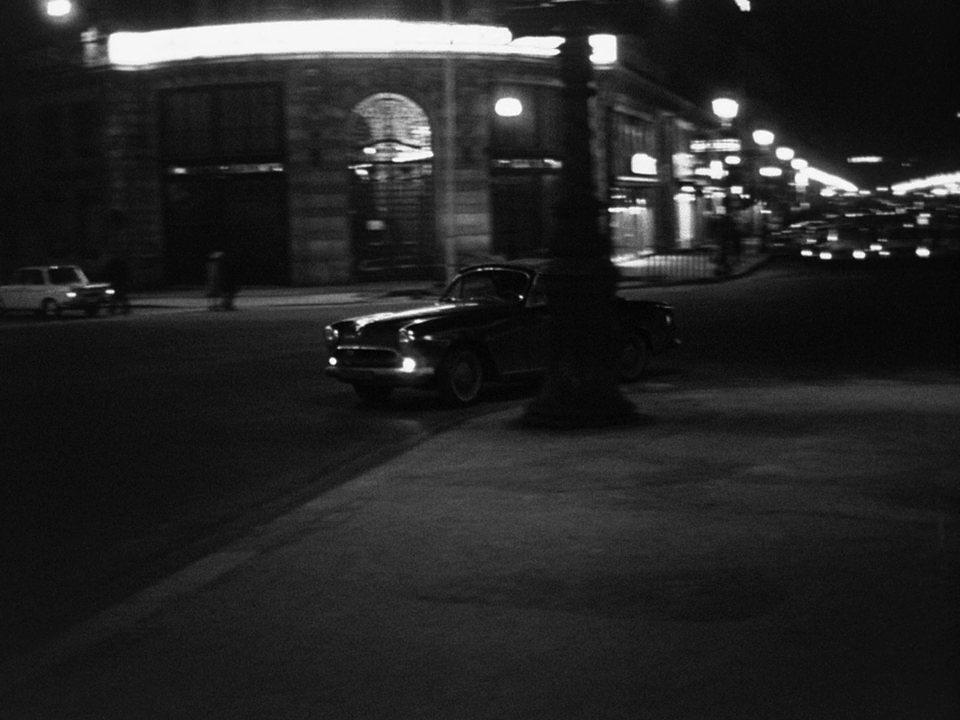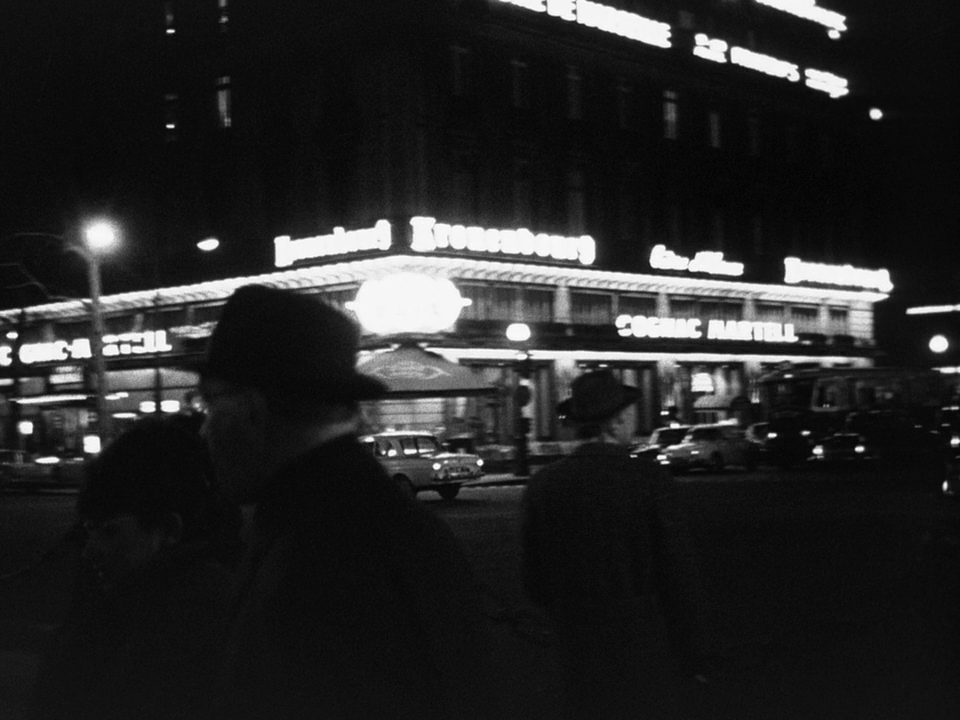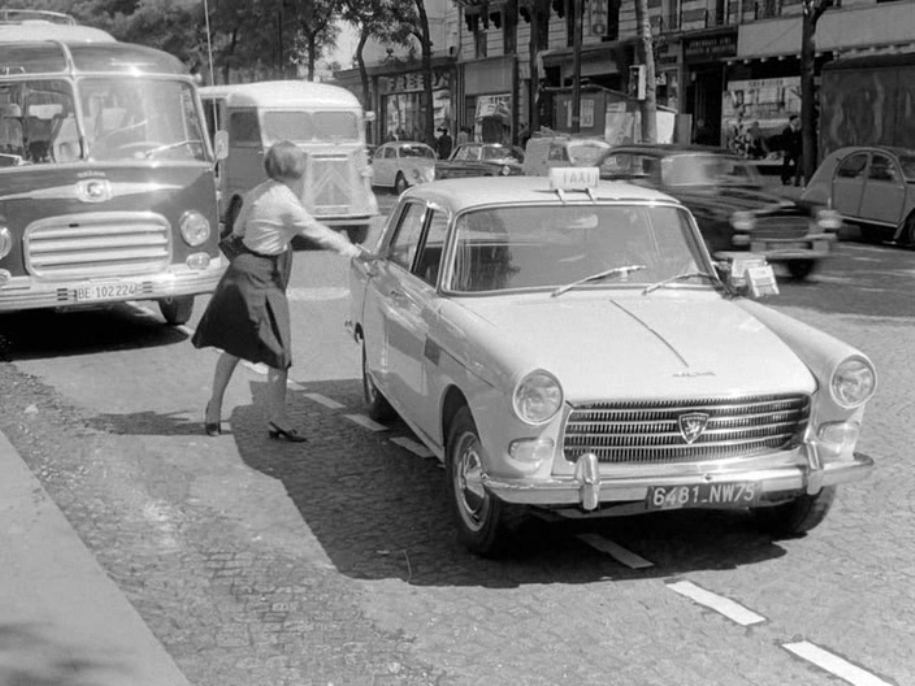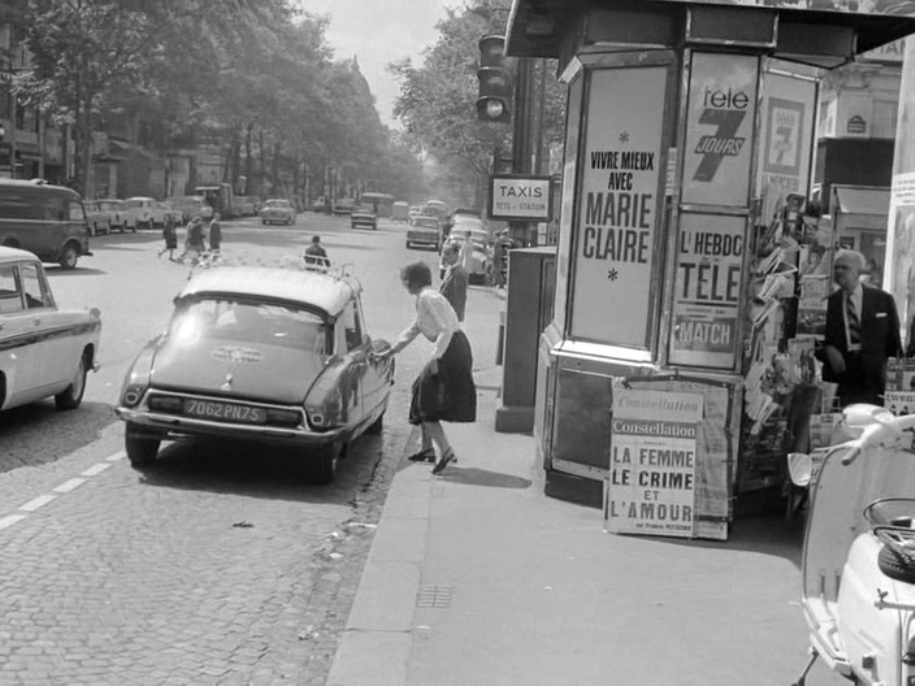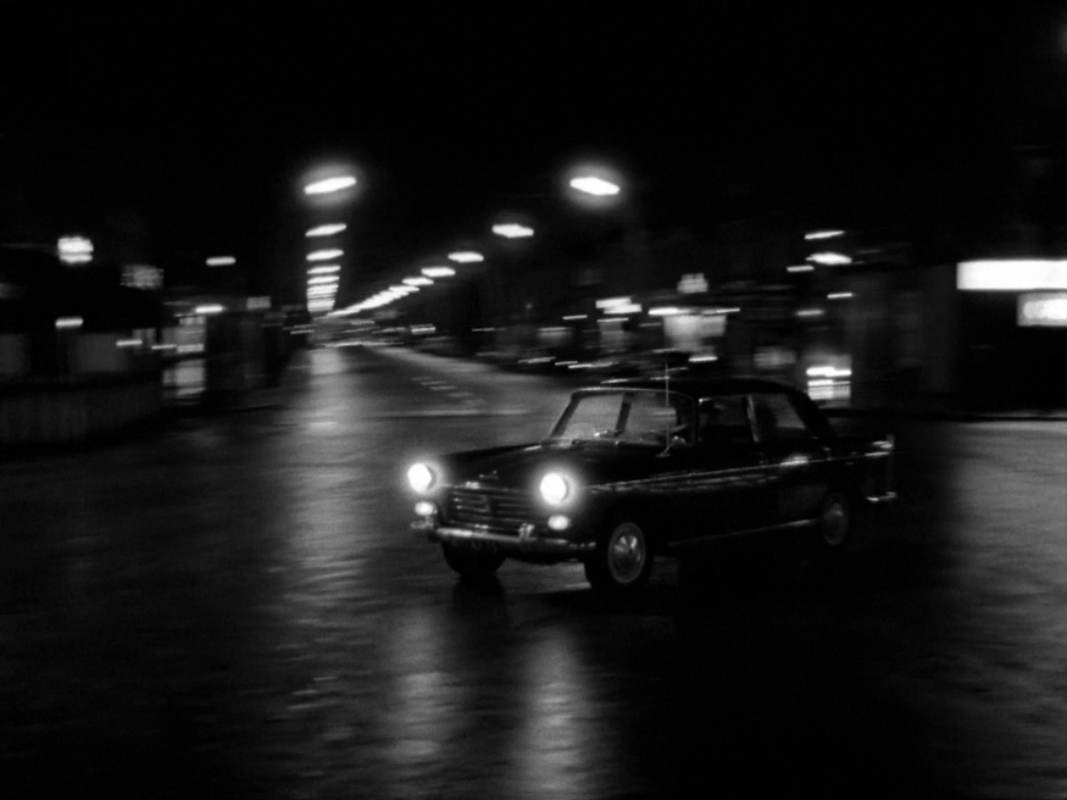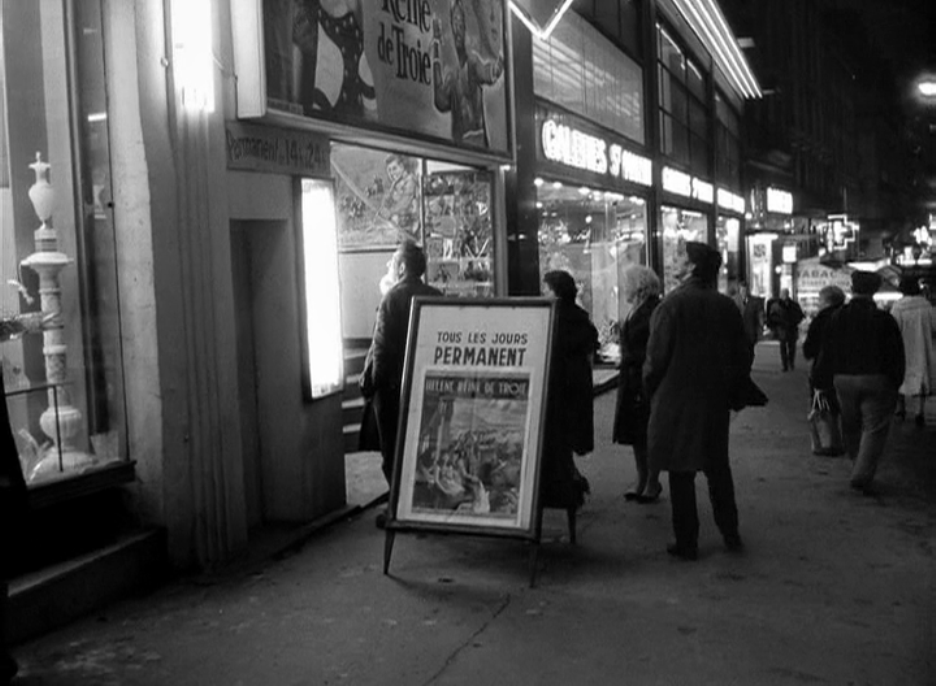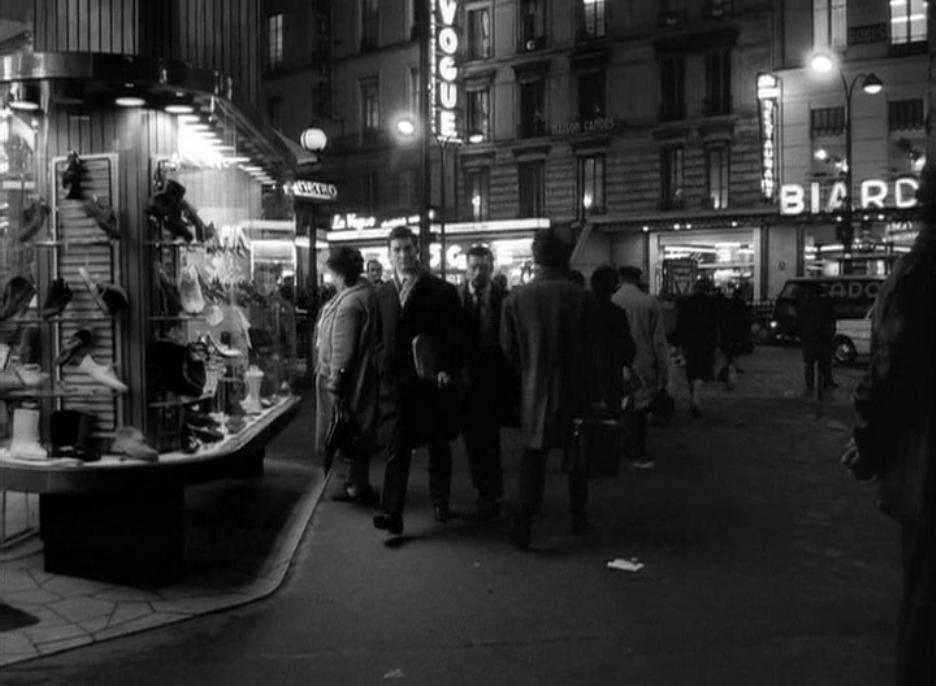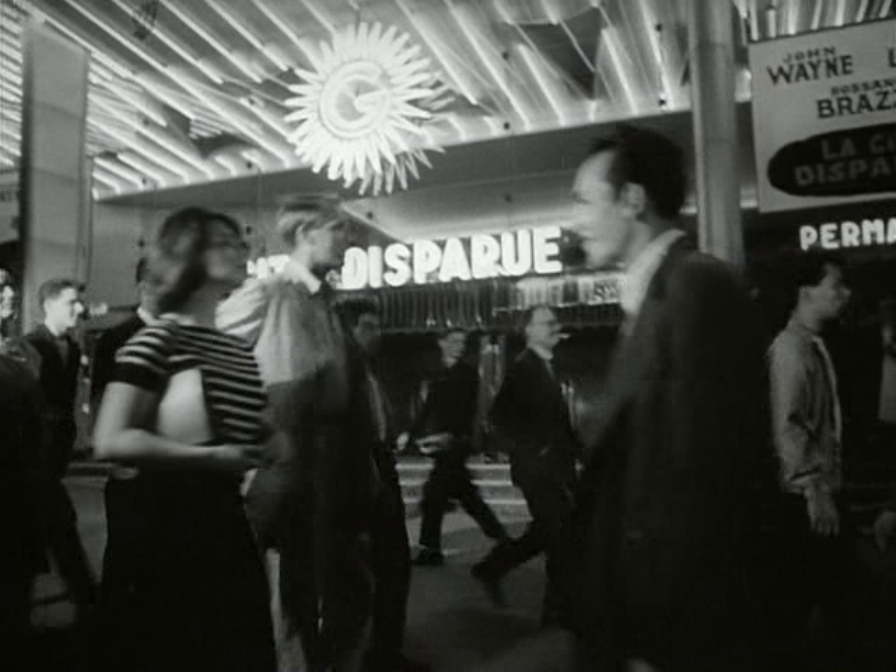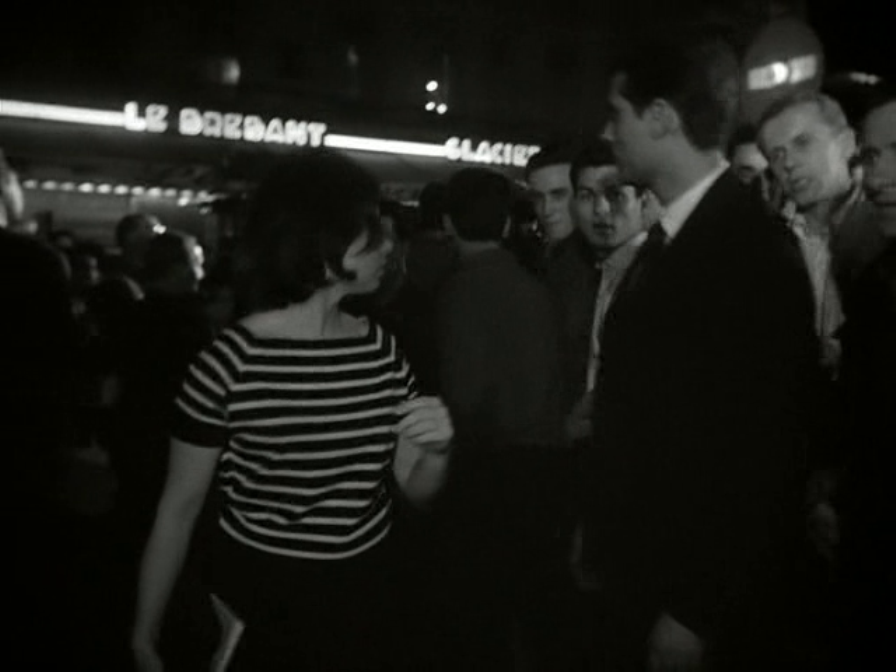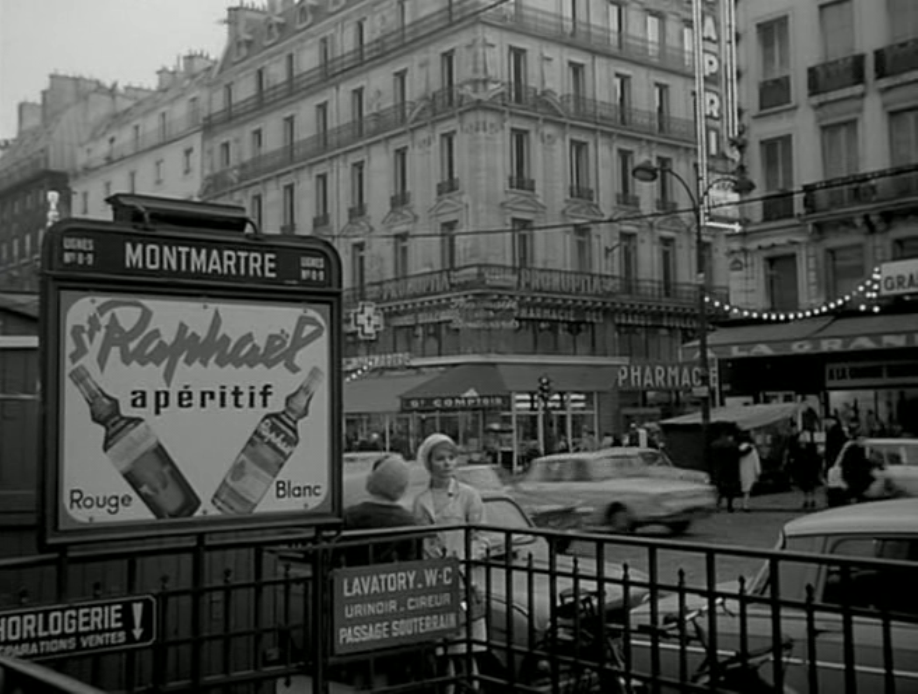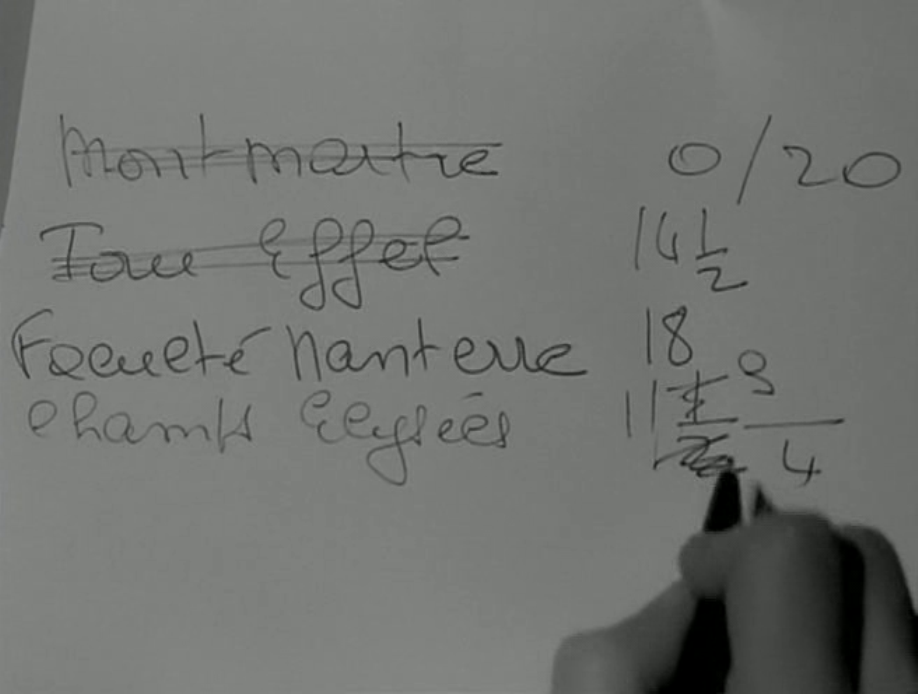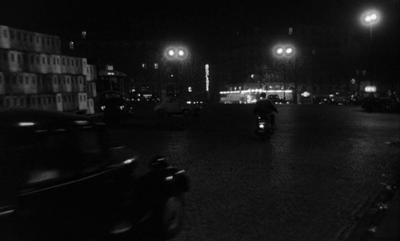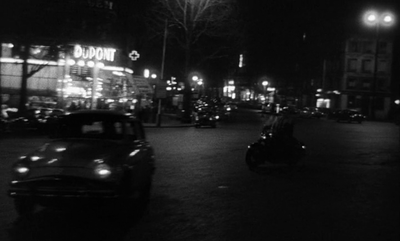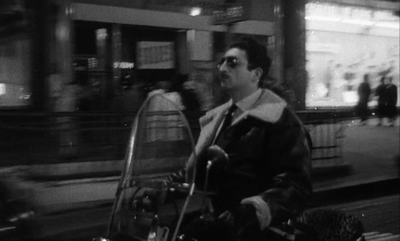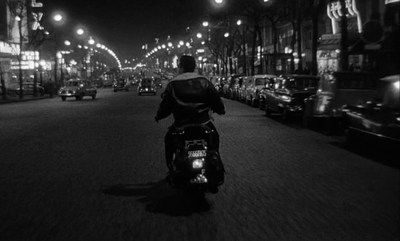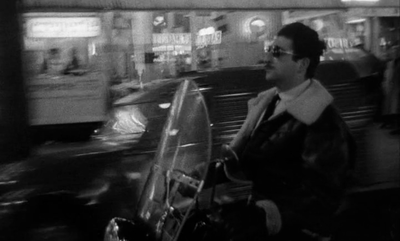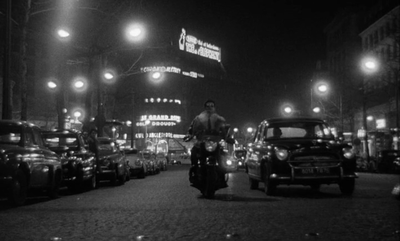walking on the boulevard des Italiens in New Wave Paris
The place of the boulevard des Italiens in the visual history of Paris is due in some part to its being painted by Pissarro in 1897, twice, and earlier by Caillebotte in 1880. Caillebotte's study of the grands boulevards was modelled on Monet's earlier view of the adjacent boulevard des Capucines, from 1873. The specific place painted by Caillebotte isn't difficult to identify. To the left of the canvas is the Crédit Lyonnais building, inaugurated only two years before he painted it. His view looks west from a balcony north of the boulevard, that of a friend's apartment at 2 rue Lafitte (the building is now gone):
Pissarro's two views of the boulevard des Italiens can be localised because they are part of the series he painted from a balcony of the Grand Hôtel de Russie, at the junction of the boulevard des Italiens and the boulevard Montmartre. The other paintings in the series are views eastward along the boulevard Montmartre. These two are views west along the boulevard des Italiens:
The area's associations with the cinema began at this time. At its other end the boulevard joins the boulevard des Capucines, where in 1895 the Lumière brothers began exhibiting their cinématographe at the Grand Café. In 1896 Georges Méliès began including films in his magic shows at the Théàtre Robert Houdin, at no. 8 boulevard des Italiens.
The two films made by Méliès on the boulevard des Italiens in 1896 are lost. In the twentieth century other filmmakers would add the grands boulevards to the repertoire of Paris streets on screen. Here, in Marc Allégret's Sois belle et tais-toi (1958), is the entrance to the Musée Grévin, on the boulevard Montmartre:
This may be where Truffaut's truants are heading, a year later, as they cross to this pavement in Les 400 coups:
Here is the boulevard des Italiens near the Richelieu-Drouot métro station, in Claude Sautet's Classe tous risques (1960):
And here is the other side of the street in Carlo Rim's Escalier de service (1954):
The building in the background above is the Royal Haussmann, a cinema complex with three different auditoriums, the Méliès, the Club and the Studio. The grands boulevards became a major hub for cinema-going in Paris. In 1959, in the 1.5 kilometres of boulevard between the place de l'Opéra and the porte Saint Denis, there were at least twenty-one cinemas, with ten on the boulevard des Italiens.
This post is about five sequences from five New Wave films where characters are walking on the boulevard des Italiens. The coincidence of location heightens the contrast in approach to the business of filming people walking.
Les 400 coups (François Truffaut 1959) - sequence filmed in December 1958
As part of their day skiping school, Antoine and René go the cinema on the grands boulevards, first to the Astor at 12 boulevard Montmartre then to the Cinéac at 5 boulevard des Italiens:
The films playing in these cinemas are Liane, die weiße Sklavin (Hermann Leitner 1957) and The Shanghai Story (Frank Lloyd 1954), starring Edmond O'Brien. The whip pan between the view of the Astor and the view of the Cineac hides a cut, leaving the impression that these two cinemas are opposite each other, rather than on different boulevards. Cinematic device sublimates topographical incoherence:
As all we see of the boulevard des Italiens in Les 400 coups (and possibly in all of Truffaut's cinema), this ten-second shot expresses the equation: 'le boulevard des Italiens = le ciné'.
The very ordinary films being shown at these boulevard cinemas contribute to this sublimation. As Phil Powrie puts it: 'the camera lifts up from street level to the sign 'CINE' (in bold uppercase) as if to express the cinema's literal ascendance, even eclipsing the film being shown, despite its lurid poster' ('The Ecstatic Pan', in Dudley Andrew and Ann Gillain (eds), A Companion to François Truffaut (Oxford: Wiley-Blackwell, 2013), p.195).
The Cahiers du cinéma reviews of these two films make clear the value Truffaut himself might have had of them:
The Cahiers du cinéma reviews of these two films make clear the value Truffaut himself might have had of them:
(See here for more on the locations of Les 400 coups.)
Le Signe du Lion (Eric Rohmer 1959-62) - sequence filmed in August 1959
In her essay 'Walking in the city: Paris in the Films of Eric Rohmer' (p.179 ff.), Fiona Handyside has demonstrated how important is Le Signe du Lion to a consideration of cinematic ambulation, central not only to Rohmer's work but also, alongside A bout de souffle and Cléo de 5 à 7, to the New Wave as a whole. I was glad, then, to discover (only recently) that this film goes walking on the street I have been preoccupied with here.
Most of the walking done by the protagonist of Rohmer's film is on the Left Bank (see here for details), but an attempt to find an absent friend takes Pierre to the area of the grands boulevards. We see him first cross from the avenue de l'Opéra towards the rue du 4 Septembre, with the Opéra-Garnier in the background:
He is then walking east to west along the boulevard des Italiens, north side, past a shoe shop and an opticians:
Then he walks down to no. 5 rue de Caumartin, finds nobody in and continues his walk south towards the junction of the boulevard de la Madeleine and the boulevard des Capucines:
He sits for a while on a bench in front of the Café Viel, at 8 boulevard de la Madeleine (I am 90% sure of this identification), and the sequence closes with him once again on the place de l'Opéra, on the west side heading back towards his habitual territory south of the river:
Handyside, following François Penz and Richard Misek, insists upon the 'deep topographical coherence' of Rohmer's films. In general I agree, but the sequence before us here is a curious exception, an example perhaps of what Penz calls 'creative topography'. We can see from this rudimentary map that the topography of Pierre's movements across these five shots is not wholly coherent:
The person Pierre is looking for is at 5 rue de Caumartin (location 3), so why does he turn right from the place de l'Opéra (location 1) and go all the way to the other end of the boulevard des Italiens (location 2), rather than turn left onto the boulevard des Capucines? That after the rue de Caumartin he is at the Café Viel (location 4) does make sense, as does his arriving on the place de l'Opéra from the boulevard des Capucines (location 5), so it is only the five-second shot on the boulevard des Italiens that is topographically incoherent. Remembering the topographical sleight of hand that brought Truffaut's truants onto the boulevard des Italiens, we might imagine that Rohmer had a specific reason for bring Pierre there. What we see in the shot is not very promising; at best the shoe shop - Chaussures Francis at 12 boulevard des Italiens - is a motif to be echoed by the eventual disintegration of Pierre's shoes. There is no ocular theme that the optician-as-motif might signal.
(For other aspects of Les Signe du Lion see here.)
A bout de souffle (Jean-Luc Godard 1960) - sequence filmed in August 1959
Here, as in Les 400 coups and Le Signe du Lion, the boulevard des Italiens is shown in a single shot, but this shot lasts ninety seconds, not just ten or five. Before the sequence begins we see Michel and Patricia at the junction of the boulevard des Italiens and the boulevard Haussmann, known as the carrefour Drouot. They are, in effect, standing on the site of the Grand Hôtel de Russie, demolished when the boulevard Haussmann was extended in the 1920s:
To the right can be glimpsed the corner of the Royal-Haussmann cinema. Here it is about two years before:
Michel leaves to find some money, which he does by robbing Cahiers du cinéma critic Jean Domarchi in the toilets of a nearby café. When Michel returns Patricia has started walking down the boulevard des Italiens, north side, heading west towards the place de l'Opéra. They walk together in a single plan-séquence from the junction with the rue des Italiens, past the Caméo cinema at no. 32 ( the film playing is The Last Blitzkreig, with Van Johnson) and on towards the rue du Helder - about 65 metres:
The camera is close to the ground, angled up towards them, repeating the procedure in an earlier sequence
between these two on the Champs Elysées:
between these two on the Champs Elysées:
The series is completed much later in the film by a shorter, more simple plan-séquence in a corridor leading onto the Champs Elysées, with the camera behind them this time, and held higher:
The first Champs Elysées sequence has a varied pattern, beginning with the camera tracking behind them until they reach a corner, stop and turn towards the camera, so that it tracks backward to keep its distance, adjusting its speed. The boulevard des Italiens sequence is shorter and simpler, but is in several ways varied. Firstly, through the dialogue, which for the first half is taken up by Michel relating a story he'd read in the paper, and for the second by Patricia explaining that she is late for a meeting. Secondly, through the variations in framing as the camera is nearer or further from the couple:
And thirdly through the interactions with passers-by on the boulevard, of which there are two kinds, staged and spontaneous. Of the first kind, I think, is a Jean Seberg lookalike who comes up behind the couple, looks intently at Seberg as she passes, and then crosses from right to left between the couple and the camera:
More obviously a staged encounter is the soldier who comes from behind the camera and moves in front of it to ask Michel for a light:
The soldier is played by Jean Herman, husband of the film's assistant editor Lila Herman. Jean Herman was at the time actually on leave from his service in the French Army's film unit, though I think his uniform here is U.S., not French (any insight here, please). He worked as an assistant on Rivette's Paris nous appartient and would soon be a filmmaker in his own right. Later, under the name Jean Vautrin, he would be a successful novelist.
Among the images above we see a young man in a light jacket observing intently the exchange between Herman and Belmondo. He is just one of at least twenty-five passers-by whose attention is drawn by the scene being played out. Here are a few more instances:
Among the images above we see a young man in a light jacket observing intently the exchange between Herman and Belmondo. He is just one of at least twenty-five passers-by whose attention is drawn by the scene being played out. Here are a few more instances:
'We were on the boulevard des Italiens, with Coutard, the cameraman, in a little postal delivery cart. He filmed through a hole while we played our roles' - Jean-Paul Belmondo, quoted in François Guérif & Stephane Lévy Klein, Belmondo (Paris: PAC, 1976), p.31.
Belmondo's description of the shoot suggests that an effort was made to conceal the filmmaking apparatus, but it is clear from many of the instances above that it is not the actors who draw the attention of bystanders but the crew filming them. To this woman, as she looks straight into the camera, it must have been quite clear that she too was being filmed:
Belmondo's description of the shoot suggests that an effort was made to conceal the filmmaking apparatus, but it is clear from many of the instances above that it is not the actors who draw the attention of bystanders but the crew filming them. To this woman, as she looks straight into the camera, it must have been quite clear that she too was being filmed:
Here is the postal cart at work in the earlier sequence on the Champs Elysées, in photographs by Raymond Cachetier:
(For other locations and other things in A bout de souffle see here.)
Adieu Philippine (Jacques Rozier 1962) - sequence filmed in September 1960
The parallel sequence in Adieu Philippine (Jacques Rozier 1962) lasts about 130 seconds and is made up of sixteen shots. Most but not all of these are filmed on the boulevard des Italiens, following Juliette and Liliane as they walk west to east along its south side, the other direction from that taken by Michel and Patricia in A bout de souffle, and on the opposite side of the street:
|
Every shot shows the two women walking right to left, and the consistency of their appearance and framing against different backgrounds makes each transition a jumpcut. This type of sequence-composition is a lesson learnt from a sequence near the end of Jean Rouch's 1958 film Moi, un noir, tracking the subjects through disparate shots across jumpcuts, with continuity imposed by the consistent appearance and demeanour of the subjects and by continuity on the soundtrack.
|
|
In Adieu Philippine Rozier has developed the form of the jumpcut by playing on whether it is perceptible. He deploys what to me looks like four degrees of perceptibility. The first is where the cut is obvious because the image each side of it is completely different. This is the case for seven of the fifteen cuts in the sequence:
The second category is where the image each side of the cut is different but our perception of the difference is restricted by the proximity of objects to the camera and by their similarity to each other. Here there is a tree in the foreground of each shot that creates a match of sorts across the cut:
And here, though we might perceive the difference between the back of a man's jacket and the rear window of a car, the shots are matched by the blurred focus on each object - a function of proximity:
This cut may belong in the first category, depending on whether the car windows through which the camera films are registered as similar, despite the degrees of blur and distance:
The third category is where the similarity of image each side of the cut makes the cut almost imperceptible. There are five of these, the first of which shows the same café at different times:
In these four instances the cut is disguised by occurring between shots of cars close to the camera:
As I have said, the perceptibility of the cut is relative, and it may seem that some of the above belong in the second category. A factor in their perceptibility I haven't rendered is that the camera in the sequence is always moving right to left, so that what we see across each of the four car-related cuts above is first the back of a car and then the front of the car, so that cognitively we may perceive each time a whole car passing in front of us. The impressions we get are more like this:
My fourth degree of perceptibility is where the passage of objects - chiefly cars - in front of the camera is so rapid that we may think there is a cut when there isn't. Twelve of the fifteen cuts in the sequence feature close-ups of cars on one or both sides of the cut, eventually creating in the spectator - or at least in this spectator - an anxiety that there might be a cut wherever a car appears in close up:
The impression that different images have been cut together may be intensified in collage-like frame grabs such as the last two above, where differentiating foreground, middle-ground and background is made difficult by reflections in the cars' windows and by the sectioning of the image by the frames of those windows.
Establishing that the cutting of this sequence plays on the cuts' varying perceptibility has been somewhat laborious, and I haven't touched on other factors that make this a tour-de-force of New Wave montage. The sequence is cut very exactly to the pattern of the tango music on the soundtrack. The first shot, the longest of the sequence at thirty seconds, lasts the time it takes for the tune's nineteen-note main phrase to play twice. At the first cut a modulated passage begins, lasting thirty seconds but accompanied by ten shots. The main phrase returns, played twice, each time accompanied by a single shot. A further brief modulation is then played, followed by the main phrase once again, but the cutting together of the last three shots does not, this time, match the patter of the music.
And all this time, the two women are walking in rhythm with the tango.
And all this time, the two women are walking in rhythm with the tango.
I am reading the moment the music stops as the end of the sequence, once the women have stopped walking and are in a phone box about to make a phone call, even though that last shot continues without cutting for a further fourteen seconds. The Average Shot Length of the sequence is just over eight seconds, with an uneven distribution determined by cutting to the music, as I have described above. In the busiest passage of cutting, shots 2-11 (ASL: 3 seconds), many of the cuts are disguised, so that the contrast with the preceding single shot lasting thirty seconds is not as striking as my description may have suggested. The music ensures continuity, as does the appearance in shots 5 to 10 of the same man attempting to talk to the two women. These six shots are effectively a single shot broken up by cuts, mostly disguised:
The lengths of the last five shots are: 15 seconds, 15 seconds, 10 seconds, 10 seconds and 12 seconds.
Counting shots 2 and 3 as one place, and shots 5 to 10 as covering a single location, there are ten different places in this sequence, six of which are identified. It begins with the two women turnng onto the boulevard des Italiens from the rue Louis-le-Grand, past the Musée Jules Verne that was housed in the Palais Berlitz. They pass in front of the Berlitz cinema (playing the Gabin film Les Vieux de la vieille) at no. 31 and cross in front of the rue de la Michodière:
Logic of continuity would suggest that the café they then pass (shots 2 and 3) is the one on the opposite corner, at 29 boulevard des Italiens, but there aren't any identifying marks and, as we shall see, logic of continuity does not always apply in this sequence:
(There is in fact one clue to location, a shop's name reflected in a window from across the street, but I haven't yet found in any directory a shop in this vicinity called 'Armelle'.)
In shot 4 we see sign for a 'self service' restaurant and a board with photographs as might be found outside a cinema. There are no clues to a definite identification:
In shot 4 we see sign for a 'self service' restaurant and a board with photographs as might be found outside a cinema. There are no clues to a definite identification:
In shots 5 to 10 the women are pursued by a man, beginning at the entrance of the passage des Princes, no. 5 boulevard des Italiens, and continuing past the Cinéac cinema and finishing at the Richelieu-Drouot métro station entrance, just before the junction with the boulevard Haussmann. They are about 400 metres along the boulevard from where the sequence started:
Shot 11 looks to me like a different kind of street. Though I cannot identify this shop I would guess that they are on the rue de la Paix, as they will be again three shots later:
In shot 12 they pass a branch of the shirt shop '100,000 Chemises' at 13 boulevard des Italiens and cross in front of the rue Marivaux:
In shot 13 they are back almost where they started, passing in front of the Enoch et Cie publishing house and the Rio Opéra cinema at 27 boulevard des Italiens:
In shot 14 they are walking northwards up the rue de la Paix, passing the perfumier Caron at no.10:
In shot 15 they pass the Banque Jordaan at 23 boulevard des Italiens and cross in front of the rue Choiseul:
The location of shot 16 looks like the boulevard des Italiens but I haven't been able to pin it down. This is where the sequence stops, in a phone box:
With at least one shot on a street other than the boulevard des Italiens and at least two shots that show the women in places they would already have past, topographical coherence is not a compositional principle of this sequence. Unlike, of course, the single uninterrupted shot of the sequence on the same street in A bout de souffle. A further difference is that, whereas in A bout de souffle the soldier and the Seberg-lookalike are set-ups, none of the people the women pass appears to be an extra positioned there for the film. I can't be sure that the man who pursues them across six shots is a chance encounter but it seems like it is. Likewise the street-photographer in shot 13 who tries to get them stop, even if on the soundtrack we hear that the encounter reminds the women that their friend is planning to set up a 'photo-stop' business:
The pace at which the women walk is relatively constant, and so is the movement of the camera as it follows them. The camera's distance from them varies only slightly:
As does the angle from which it films them:
In both sequences the walkers attract the attention of passers-by, but whereas in A bout de souffle at least nine passers-by notice the camera, only three people in Adieu Philippine seem to be aware of its presence:
Une fille et des fusils (Claude Lelouch 1965) - sequence filmed in August 1964
The last New Wave walkers I have found on the boulevard des Italiens shouldn't detain us long. Near the beginning of Une fille et des fusils, Jacques sees Martine, a deaf-mute pavement artist, on the boulevard Montmartre, and follows her towards the carrefour Drouot, the junction of the boulevard des Italiens and the boulevard Haussmann, where Michel and Patricia were sitting five years before:
Jacques asks her if she wants to go walking with him by writing in chalk on the floor:
I can't tell whether the misspelling of the verb here is a Lelouchian joke (it would later be a Deleuzian one). She accepts the offer to walk, and we then see them on the boulevard des Italiens, across from the rue Favart and the rue Marivaux:
Their walking takes them up to the Butte Montmartre, beyond the remit of this post. It is also beyond this post to spend time examining how Lelouch constructs this sequence; I don't have the stomach to study his work shot-by-shot. There are some nice views of streets and cinemas in this film, but the film itself is revolting, thanks to the script, the framing, the zooming, the direction of the actors and the editing.
Here are some of those views of streets and cinemas:
Here are some of those views of streets and cinemas:
appendix: the New Wave on the grands boulevards
As well as the examples above from Les 400 coups, Le Signe du Lion, A bout de souffle, Adieu Philippine and Une fille et des fusils, there are a few other instances of the New Wave on the grands boulevards, mostly in films by Godard. The boulevards Saint Denis, Bonne Nouvelle and Poissonnière as seen in Une femme est une femme are examined here. A taxi-ride in A bout de souffle includes fleeting views of the boulevards Bonne Nouvelle and Poissonnière:
In 'Il nuovo mondo', Godard's contribution to Ro.Go.Pa.G (1963) we see again, briefly, the Carrefour Drouot, at the junction of the boulevards Haussmann and des Italiens:
In Bande à part (1964), Odile's aunt asks what Odile likes to do, getting these replies: 'I don't like cinema... I don't like theatre...'. 'What about dancing at Mimi Pinson's?' - 'I don't like that.' 'Strolling on the grands boulevards?' - 'I don't like the boulevards.' Later Franz is driving around Paris at night, on the Place de l'Opéra and the Boulevard des Capucines:
Macha Méril, as Une femme mariée (1964), gets out of one taxi on the boulevard Poissonnière and gets into another on the boulevard Montmartre:
In Alphaville (1965), Lemmy Caution's taxi passes in front of the boulevard Haussmann as it crosses the place Saint Augustin:
The street-views in Masculin-Féminin (1966) include several of the grands boulevards, including the boulevard Saint Martin and the boulevard Saint Denis:
Of the other New Wave filmmakers, Rivette shows the boulevard Poissonnière, briefly, as Anne and Philip cross Paris in Paris nous appartient (1961):
(Incidentally, in my piece 'Reading Without a Map', on the locations of Paris nous appartient, I misidentified the cinema above as the Max Linder. I'm pretty sure it's actually the Richelieu, across the street at 27 boulevard Poissonnière. Sorry about that.)
In Luc Moullet's Brigitte et Brigitte (1966), Brigitte and Brigitte go to Montmartre métro station thinking it is at Montmartre, rather than on the boulevard de Montmartre. Disappointed, they give Montmartre a zero rating:
(The métro station's name is now Grands Boulevards, to avoid confusions of this kind.)
The most topographically coherent assemblage of views of the grands boulevards in a New Wave film is, I think, the early-evening motorcycle ride of the stalker in Claude Chabrol's Les Bonnes Femmes (1960). I say I think because I can't identify every one of the nine views in this sequence, but those I can appear to be in topographical order. The first two are the place de la Bastille, the fourth is the boulevard Bonne Nouvelle, the fifth is the boulevard Poissonnière, the eighth is the junction of boulevards Montmartre, des Italiens and Haussmann, just before the carrefour Drouot, and the ninth is on the boulevard Haussmann, looking back at the boulevard Montmartre:
(For more on the locations of Les Bonnes Femmes see here.)
